Week 06 - Exploring the Literature Part I: Finding & Digesting Research
A presentation at Heritage University at CBC Week 06 in in Pasco, WA 99301, USA by Jacob Campbell
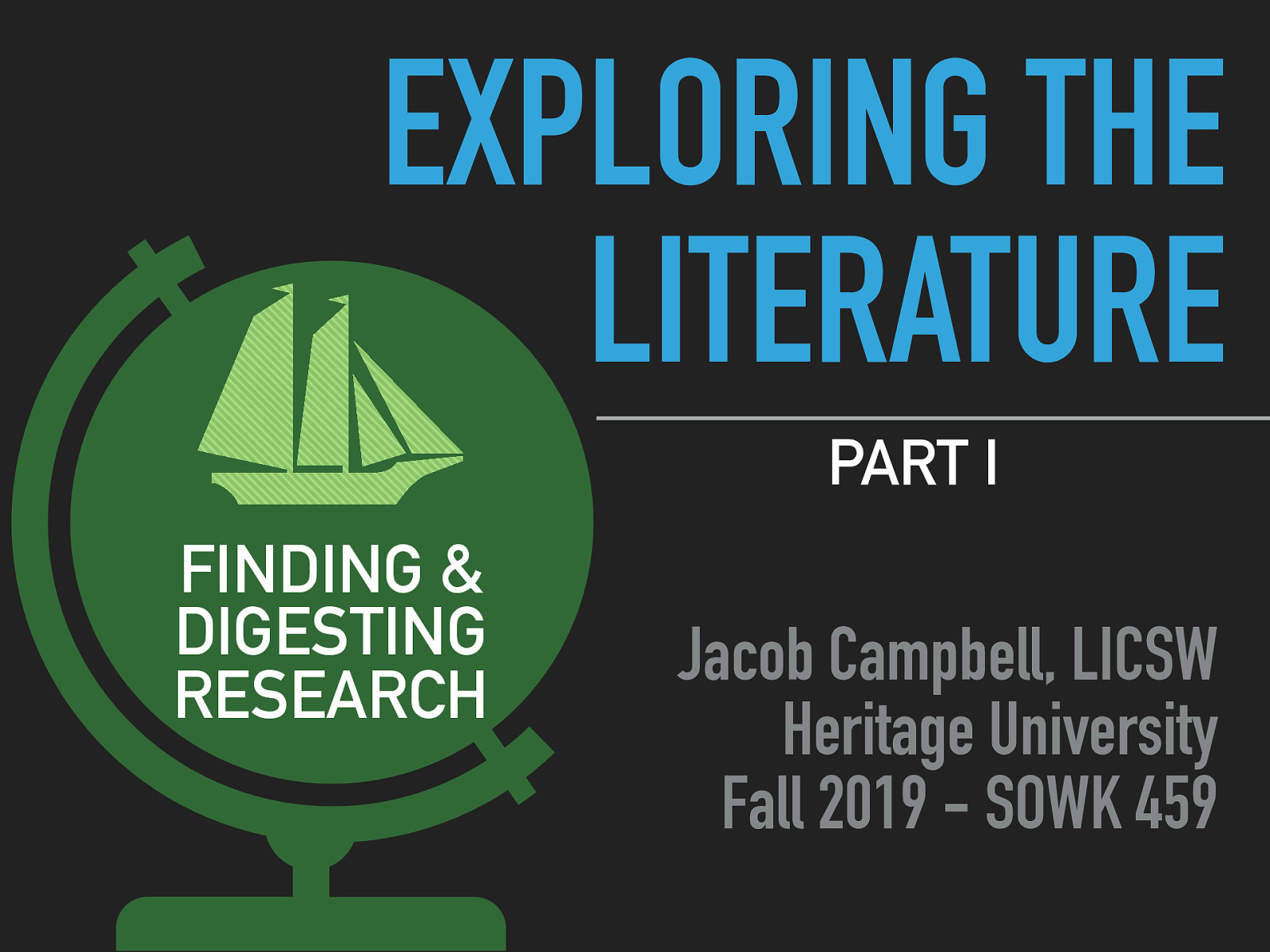
SOWK 459 Fall 2019 Planning: Class 06
Location: CBC Campus - Tuesday T-336 & SWL-220
Time: Tuesdays and Thursdays from 5:30-8:15
Week 06: 09/23/19 — 09/29/19
Reading Assignment: DeCarlo (2018) chapter three
Topic and Content Area: Exploring the Literature Part I
Assignments Due: Assignment 02: reading quiz for chapter three is due at 5:30 PM prior to class via My Heritage
Other Important Information: N/A
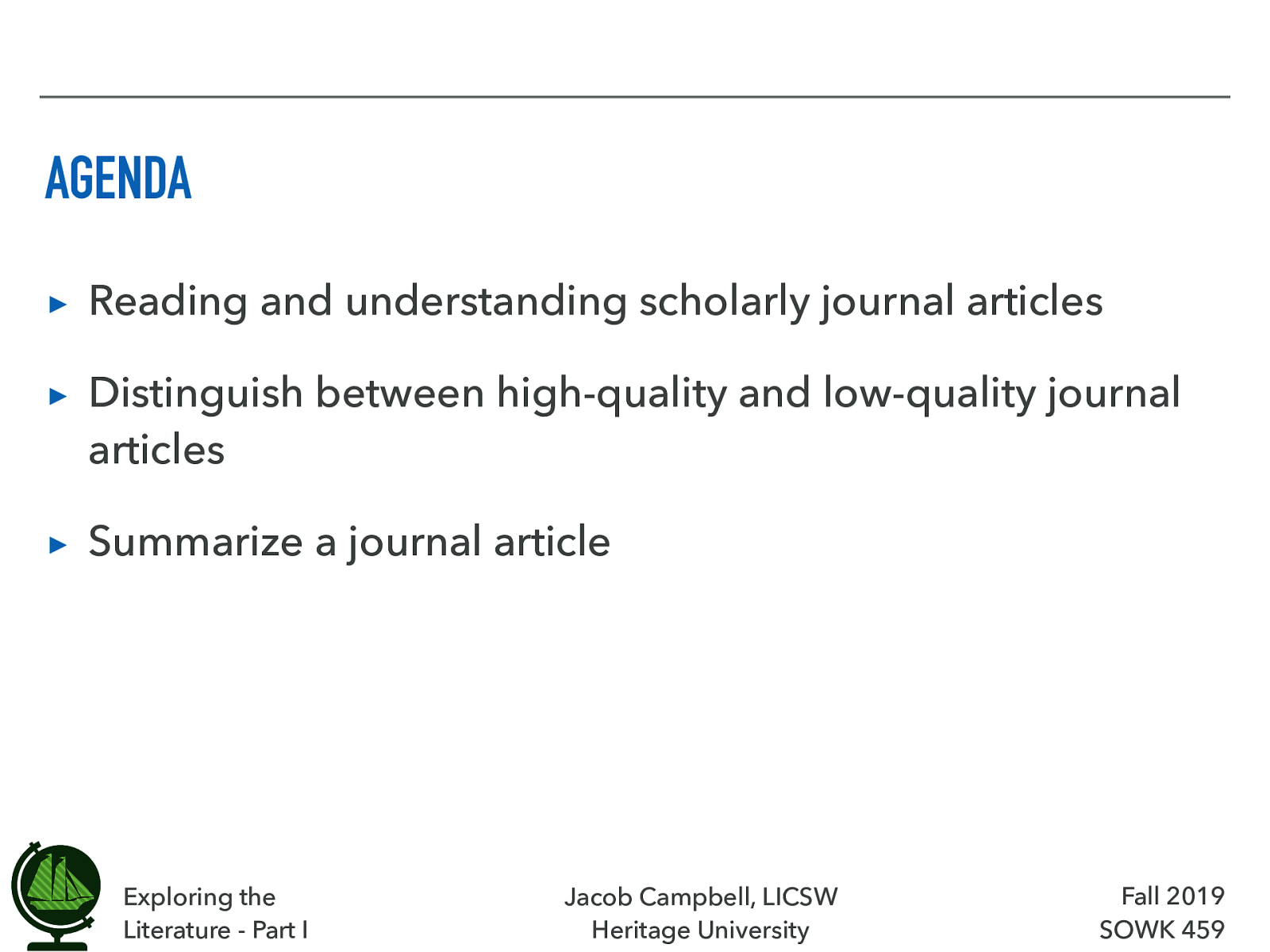
Agenda
- Reading and understanding scholarly journal articles
- Distinguish between high-quality and low-quality journal articles
- Summarize a journal article
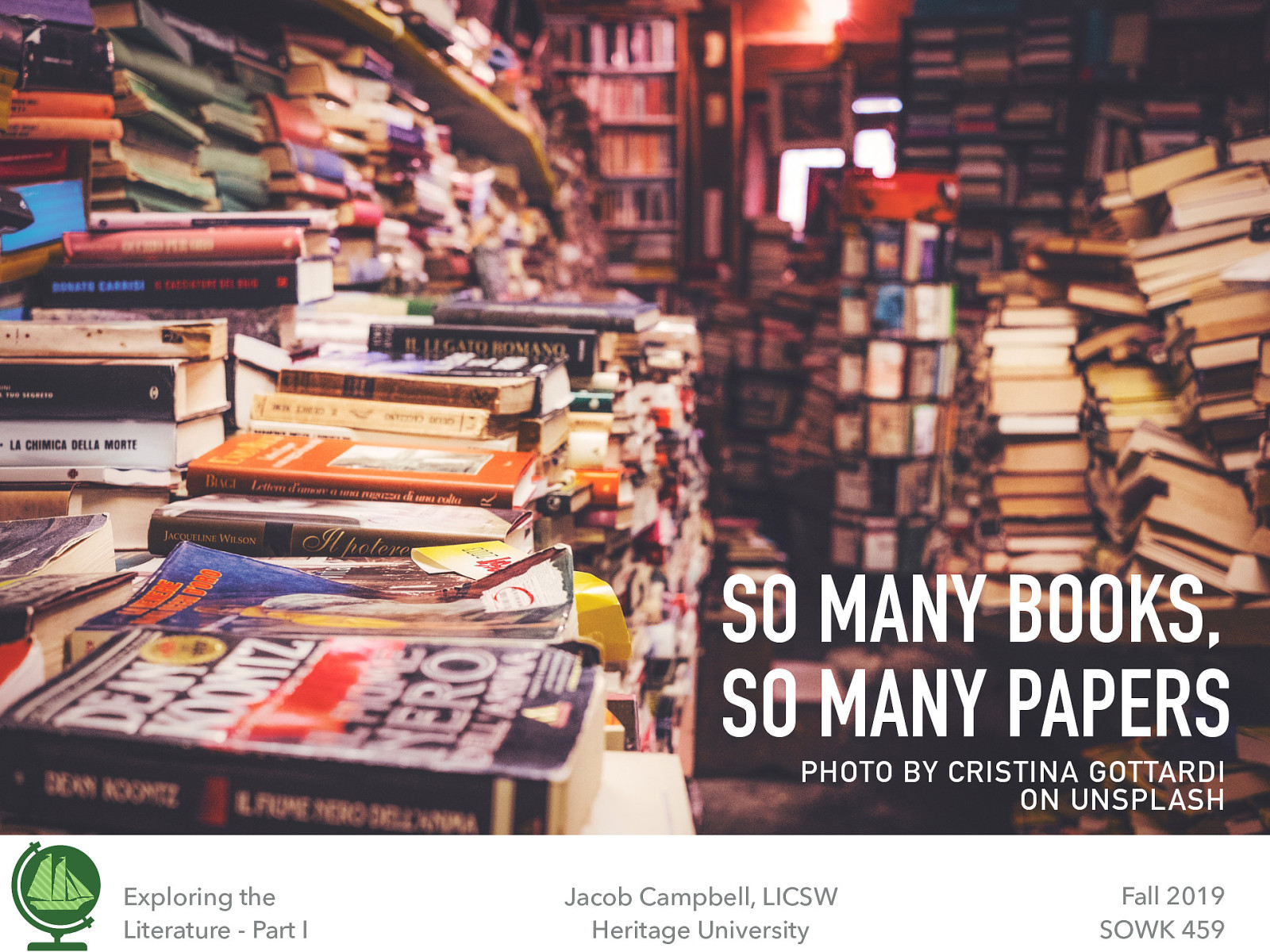
So Many Books, So Many Papers
Doing research is complicated, time consuming, and can feel overwhelming. The help learn some skills in making sense of it all.
Photo credit: Cristina Gottardi on Usplash
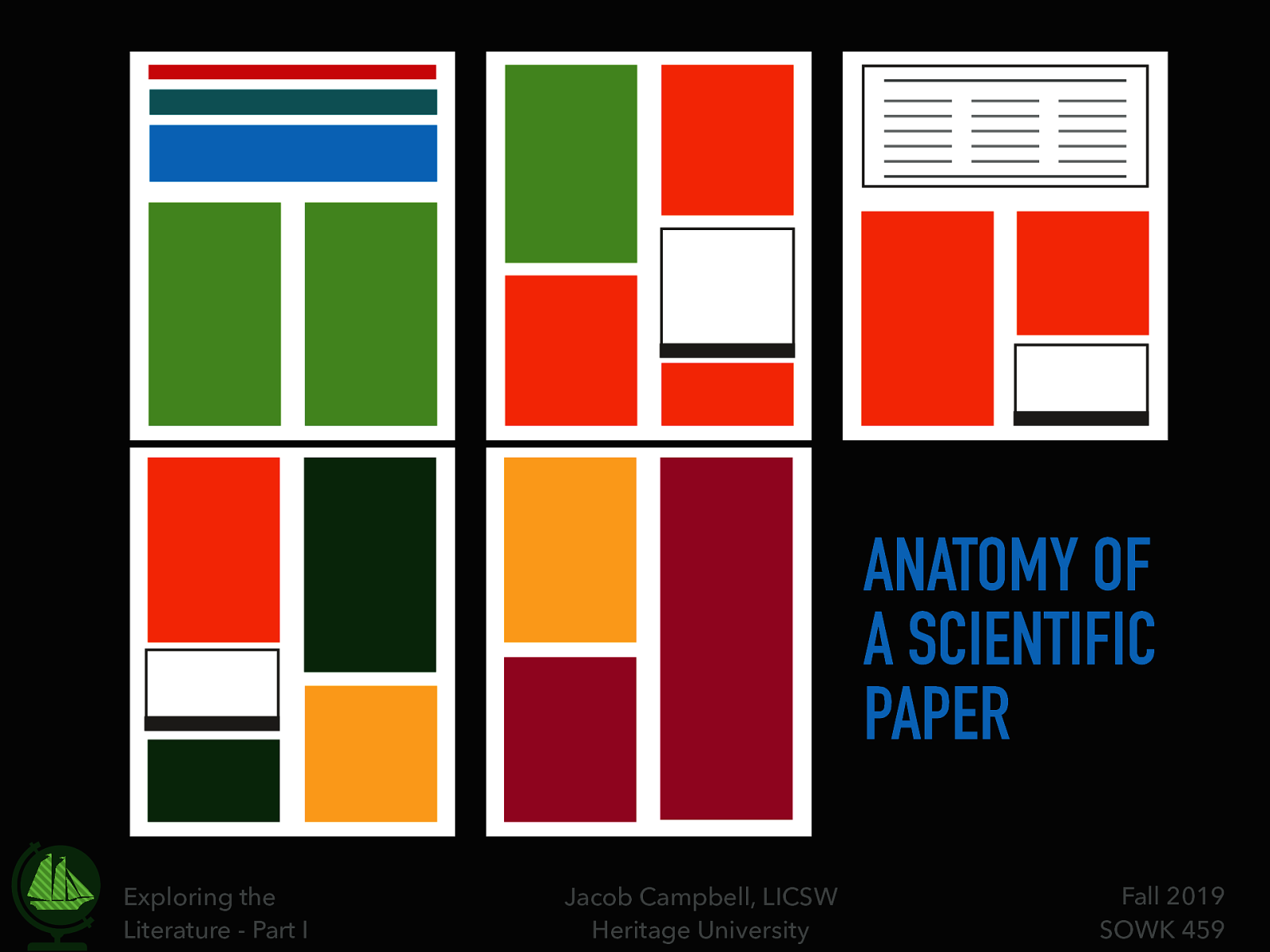
Anatomy of a Scientific Paper (1 of 10)
We can start off by looking at a scientific paper and breaking down all of the parts.
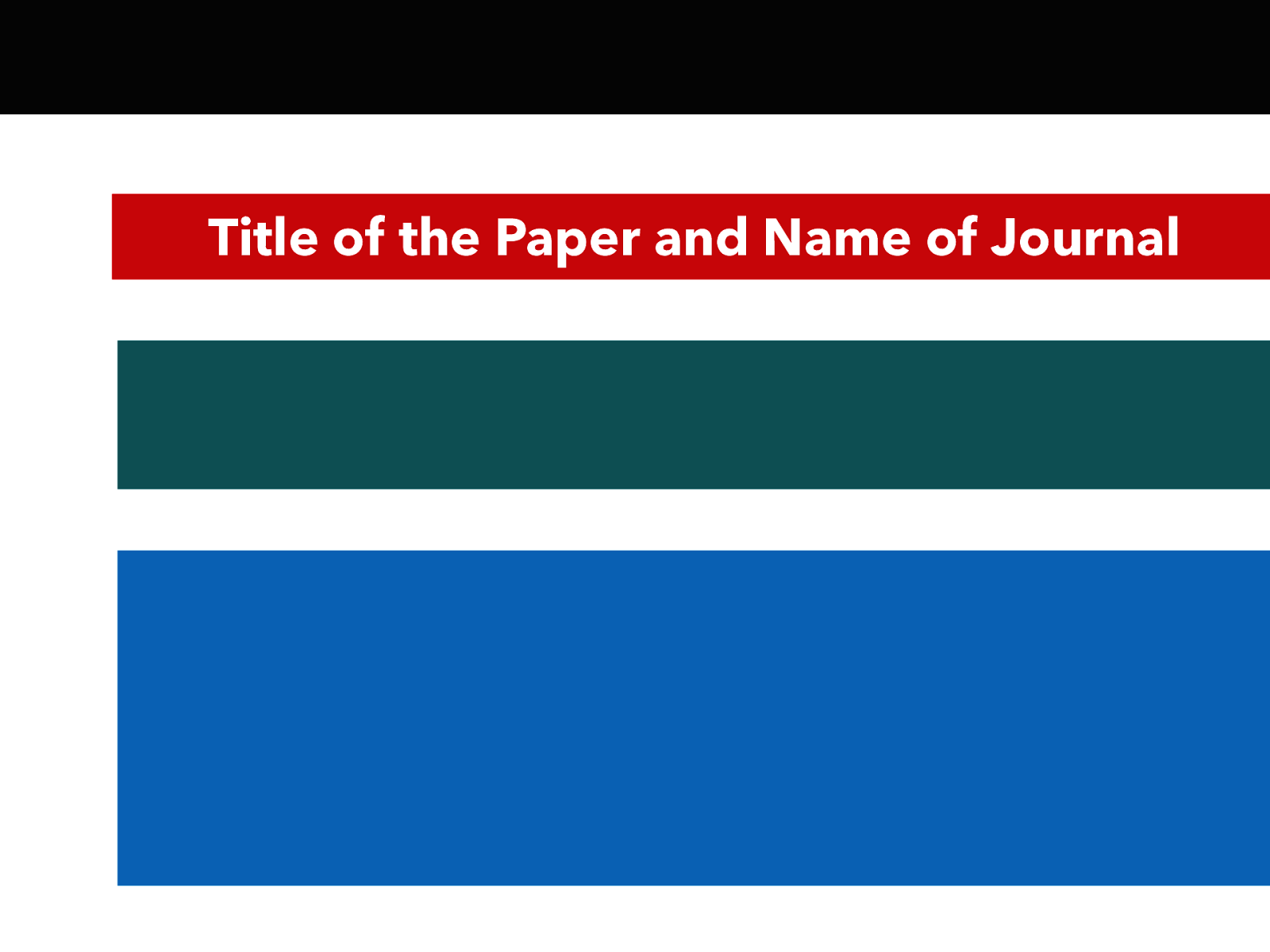
Anatomy of a Scientific Paper (2 of 10) - Title and Journal
At the top of any paper will be the title and name of journal.
- Great for getting an idea what the topic is. Most articles their title is a good description of what it is.
- The journal information is usually all together for all of the parts you need for a citation.
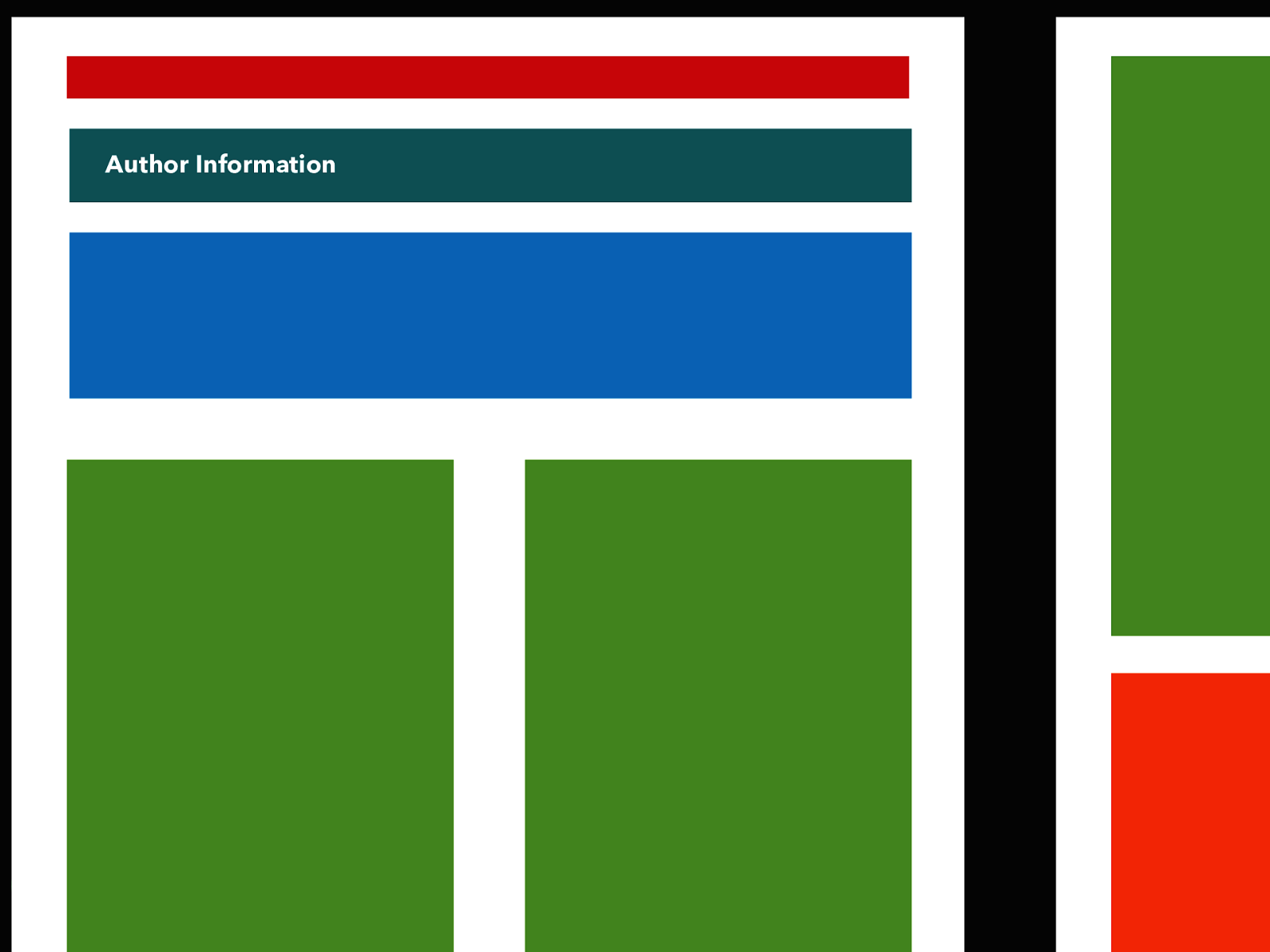
Anatomy of a Scientific Paper (3 of 10) - Author Information
There is usually a section for informationa about the author.
- What university they work for (if any)
- Potentially their degrees (although you generally don’t put that into your paper
- Sometimes biographies
- Sometimes they list things that could be considered a conflict of interest.
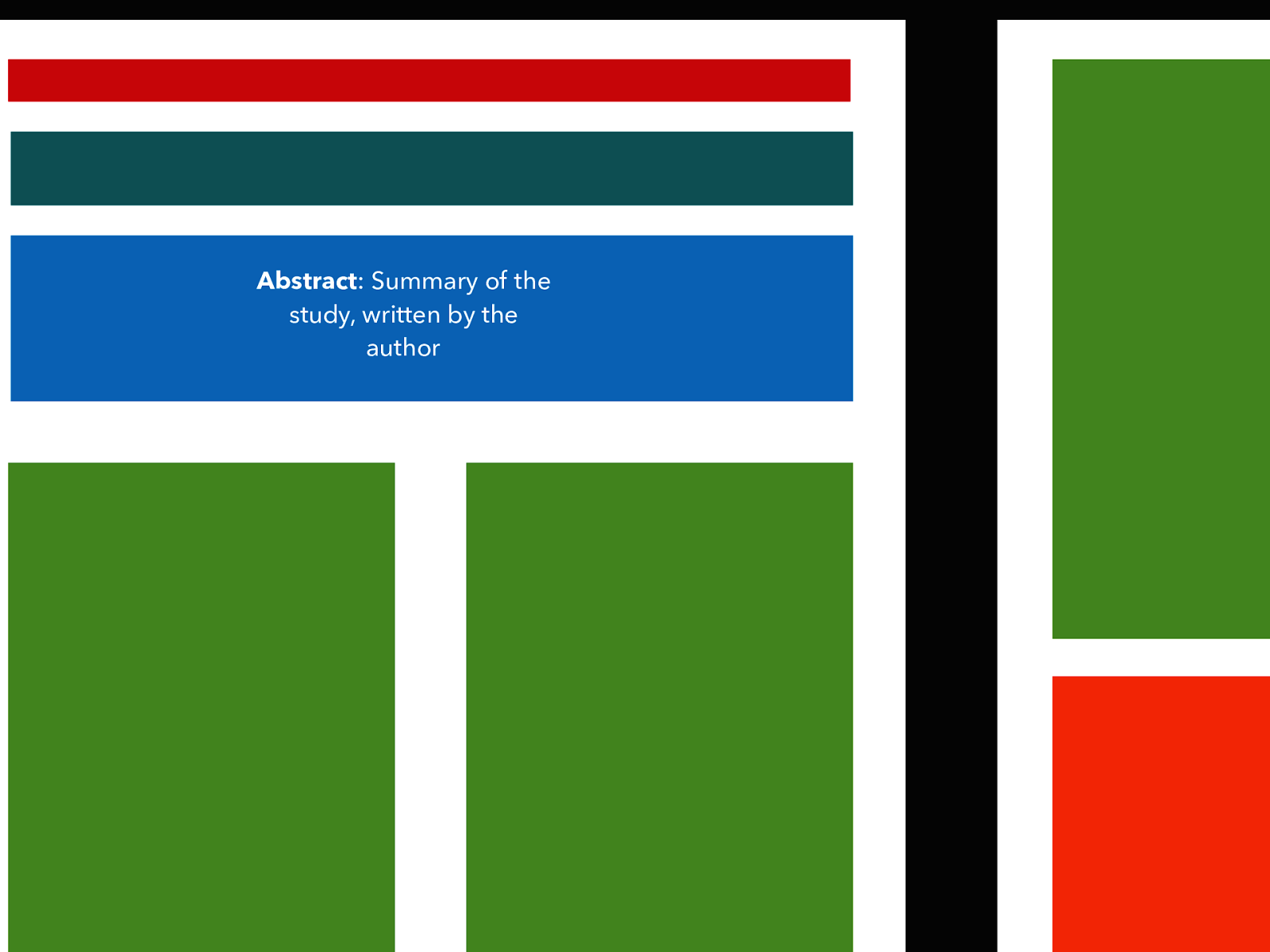
Anatomy of a Scientific Paper (4 of 10) - Abstract
Any paper will have a short summary written by the author that is a great place to start.
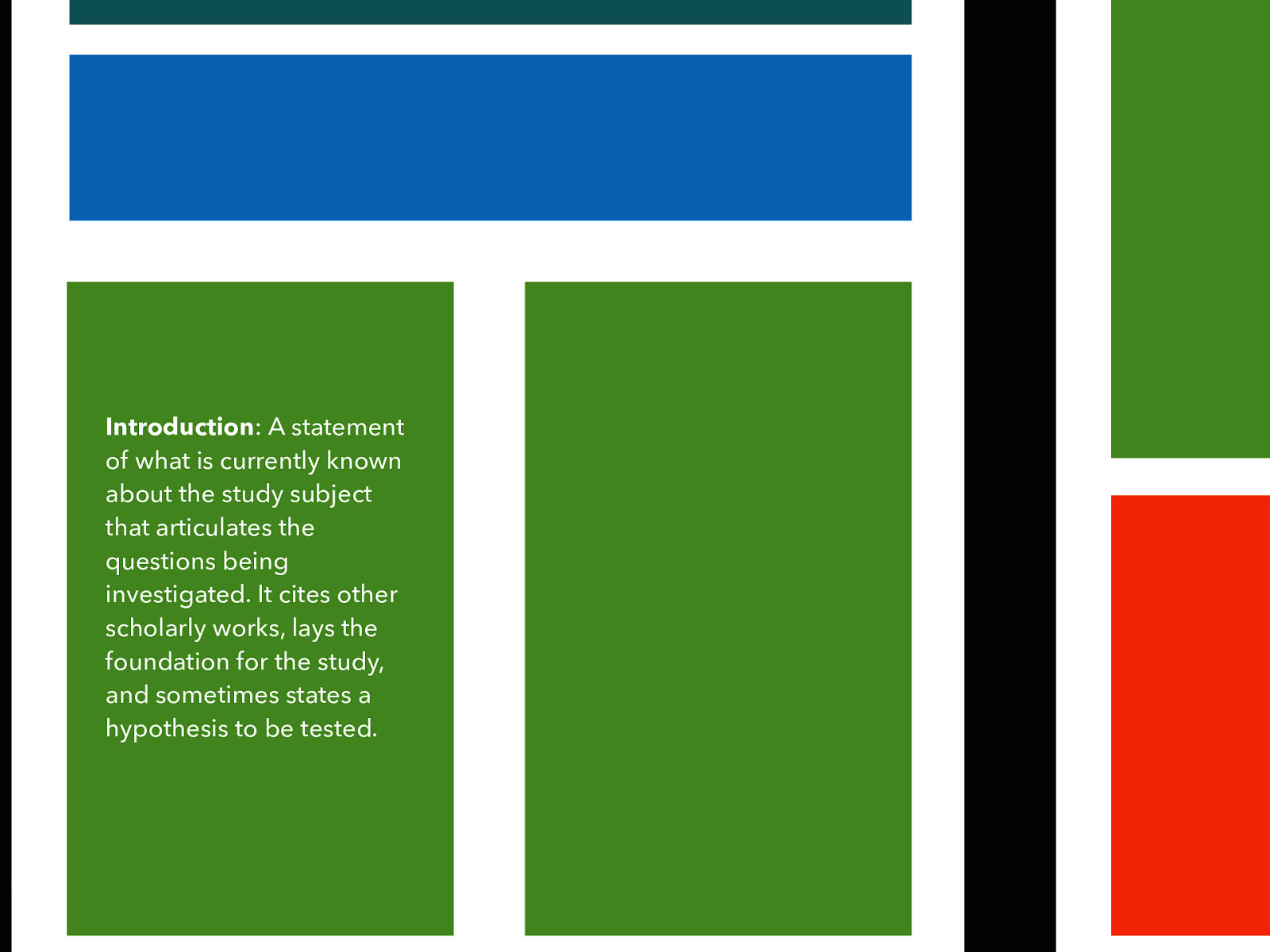
Anatomy of a Scientific Paper (5 of 10) - Introduction
Introduction: A statement of what is currently known about the study subject that articulates the questions being investigated. It cites other scholarly works, lays the foundation for the study, and sometimes states a hypothesis to be tested.
- Often this includes the literature review completed by the author.
- Sometimes there are multiple section in this section.
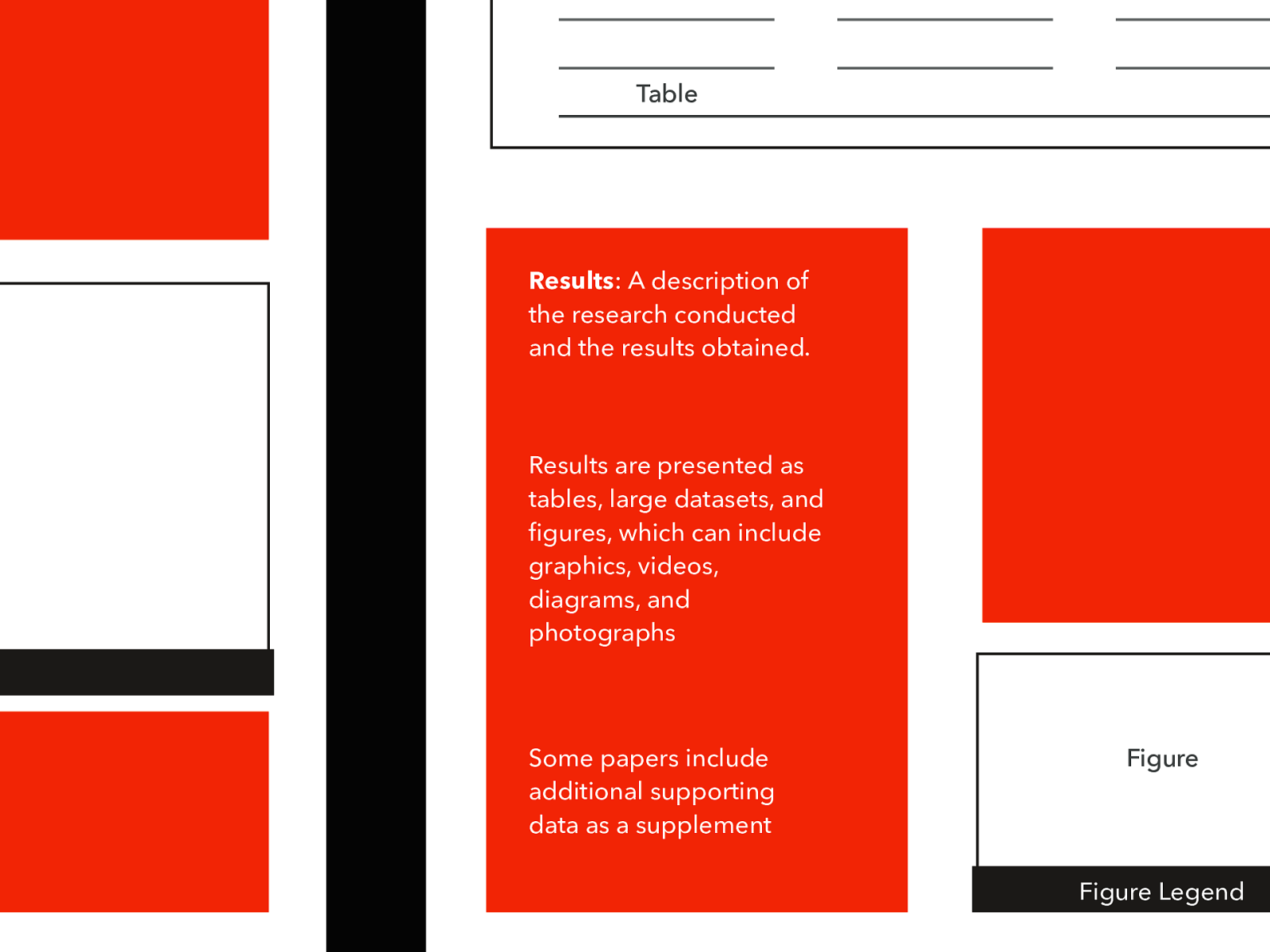
Anatomy of a Scientific Paper (6 of 10) - Results
Results: A description of the research conducted and the results obtained.
- Results are presented as tables, large datasets, and figures, which can include graphics, videos, diagrams, and photographs
- Some papers include additional supporting data as a supplement
- Very different in a more theoretical paper
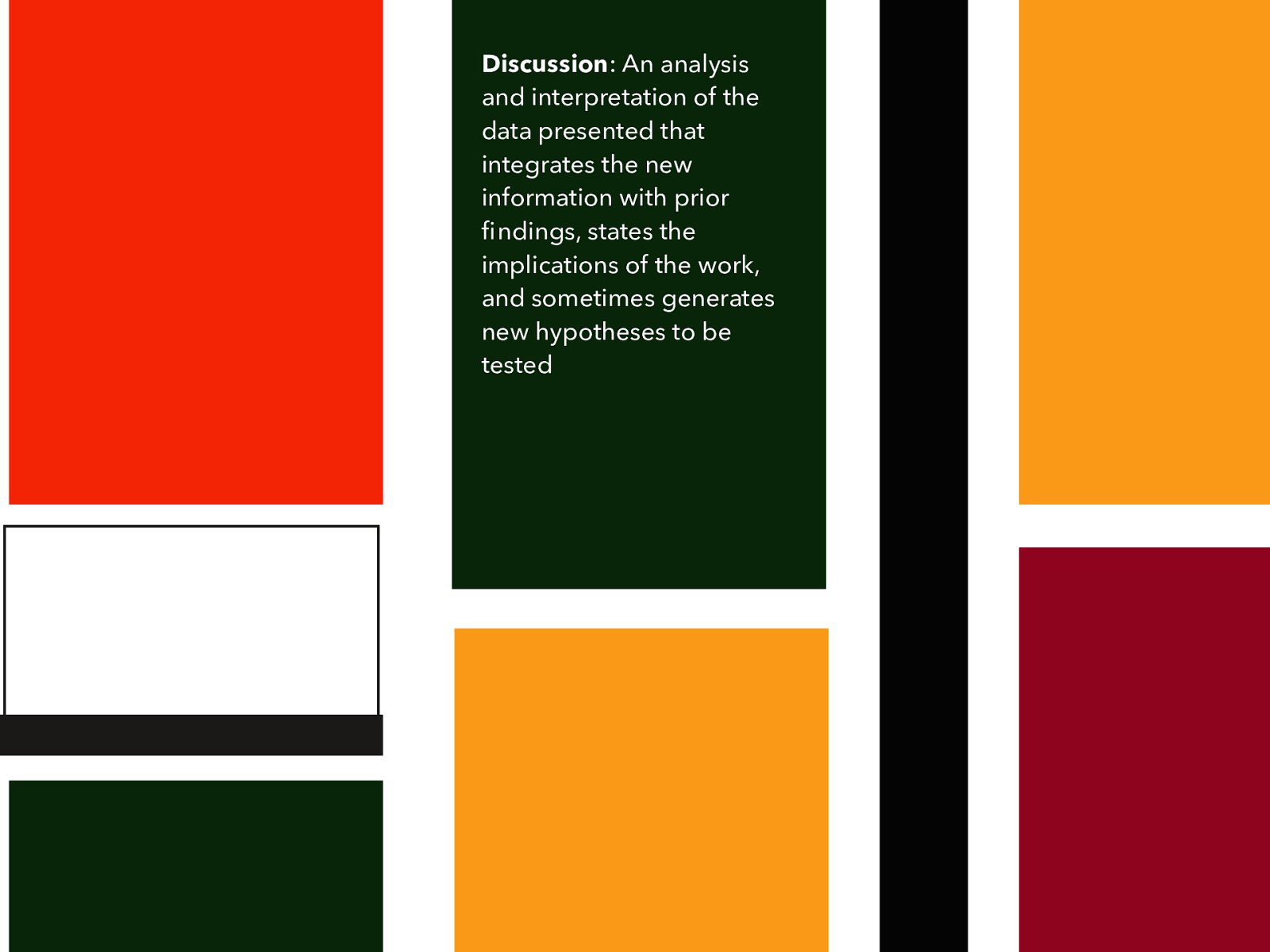
Anatomy of a Scientific Paper (7 of 10) - Discussion
Discussion: An analysis and interpretation of the data presented that integrates the new information with prior findings, states the implications of the work, and sometimes generates new hypotheses to be tested
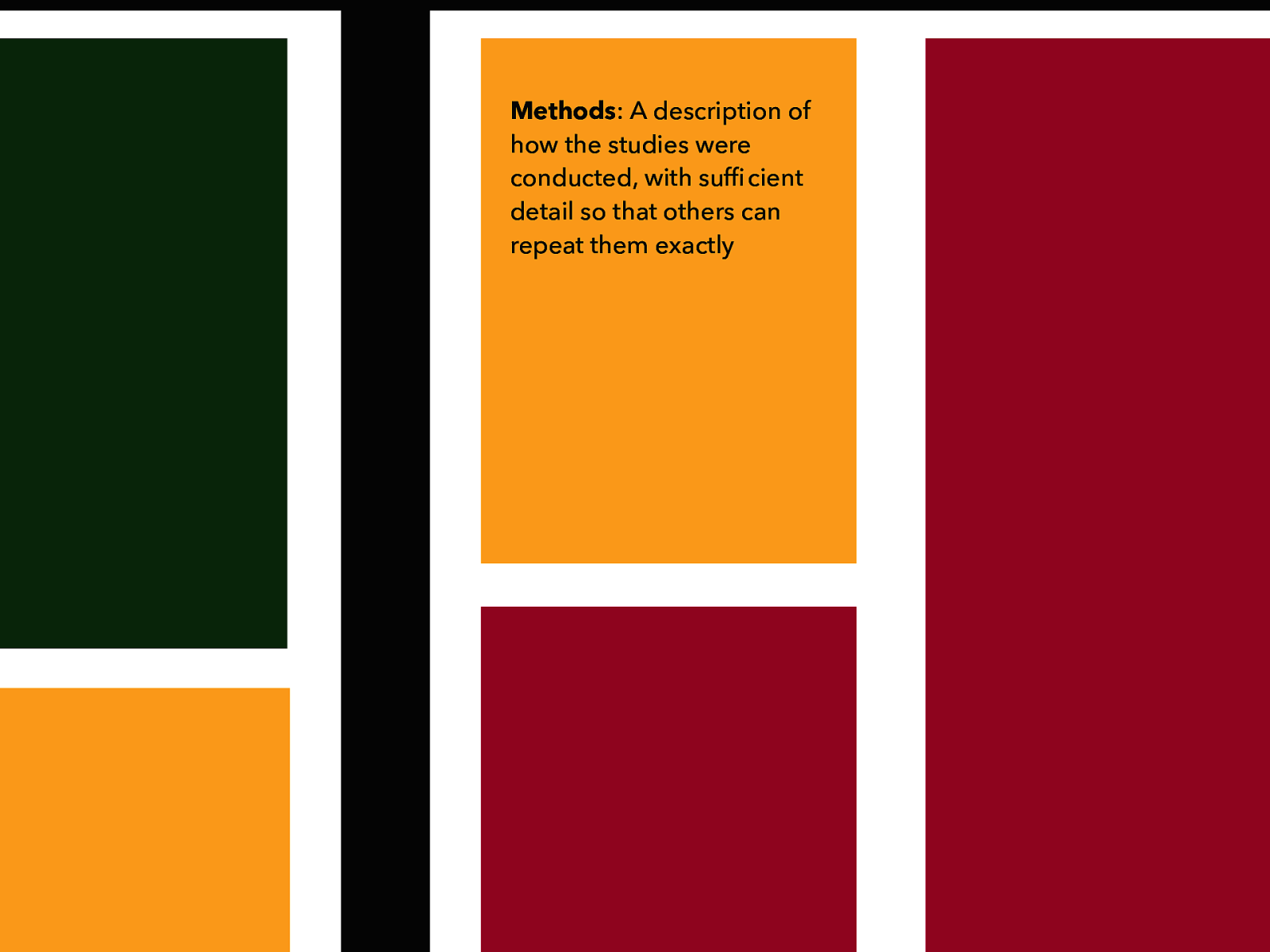
Anatomy of a Scientific Paper (8 of 10) - Methods
Methods: A description of how the studies were conducted, with sufficient detail so that others can repeat them exactly
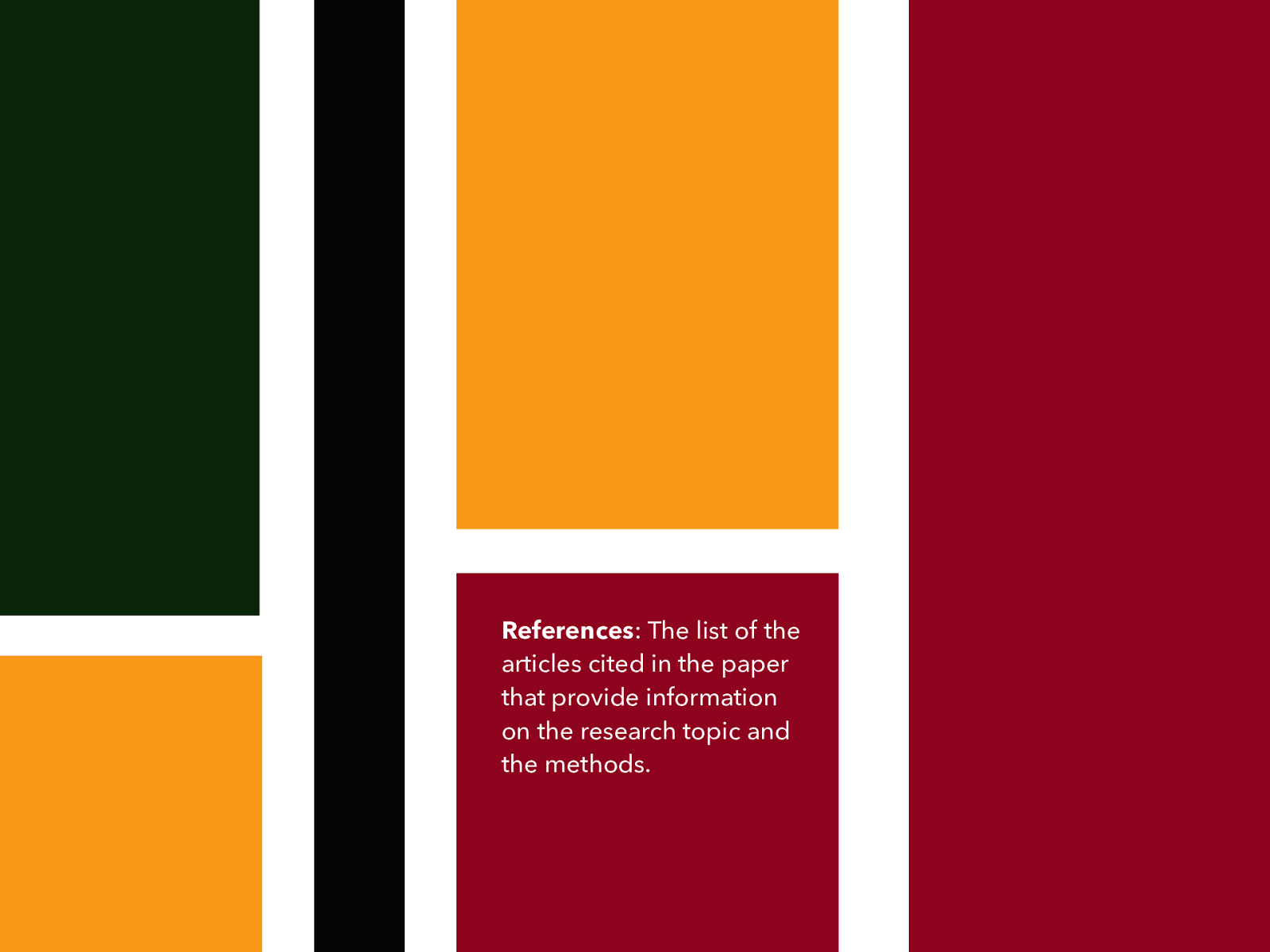
Anatomy of a Scientific Paper (9 of 10) - Reference List
References: The list of the articles cited in the paper that provide information on the research topic and the methods.
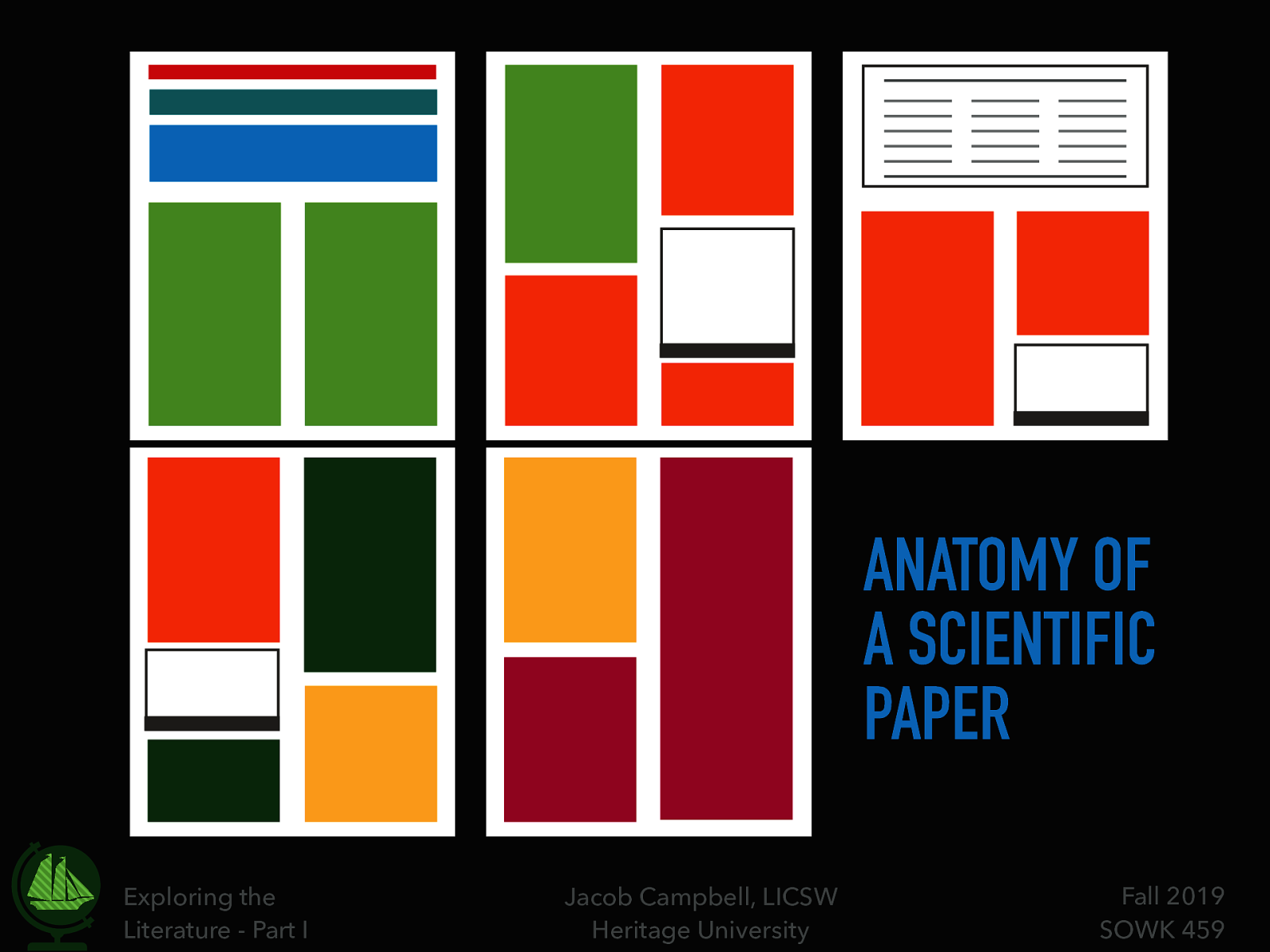
Anatomy of a Scientific Paper (10 of 10) - Overview
That is the anatomy of a scientific paper.
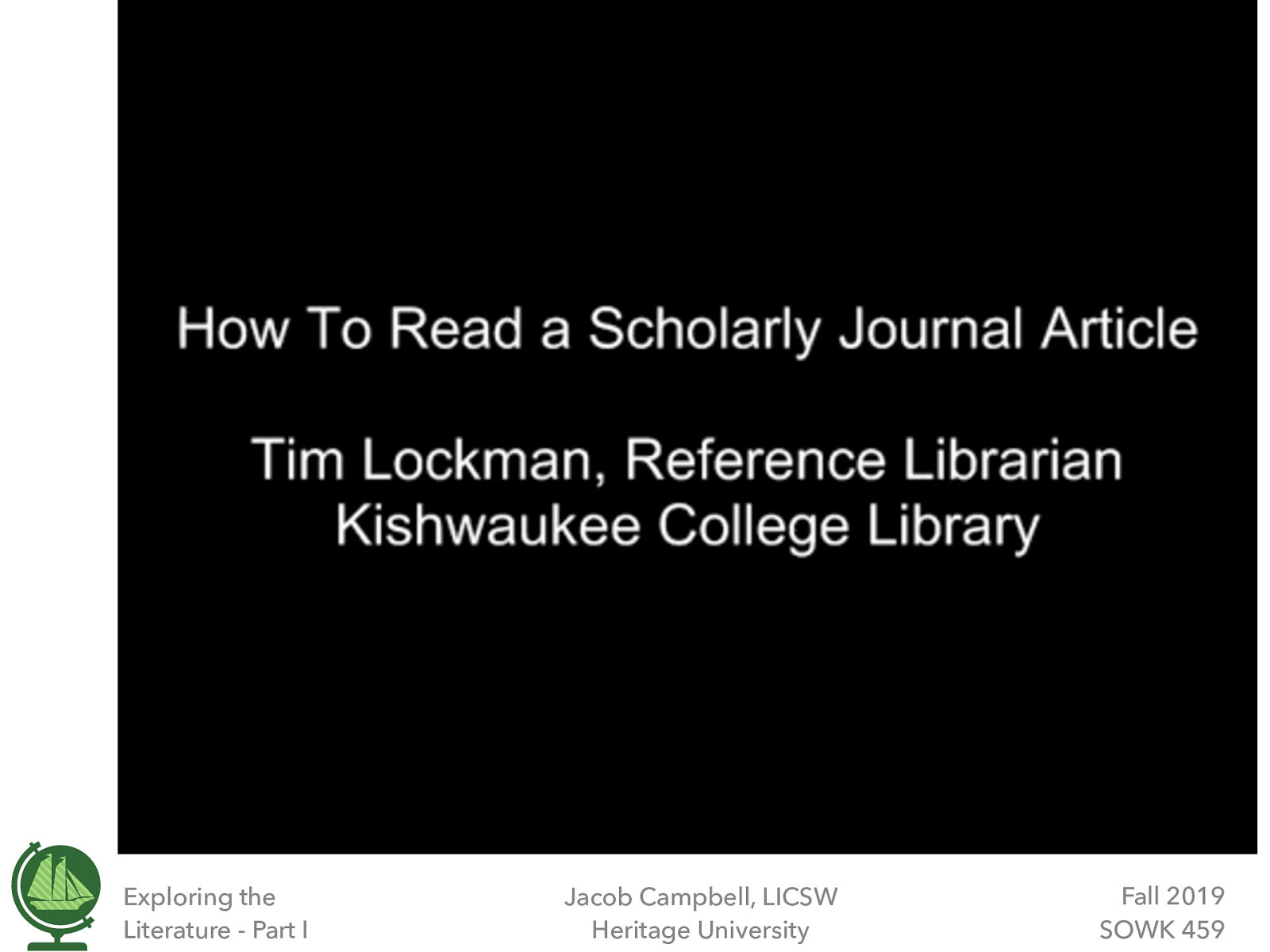
How to Read a Scholarly Journal Article
[Whole Class Activity] Watch the video. Discussion what stands out.
Lockman, T. (2012, August 12) How to read a scholarly journal article. Retrieved from https://youtu.be/EEVftUdfKtQ.
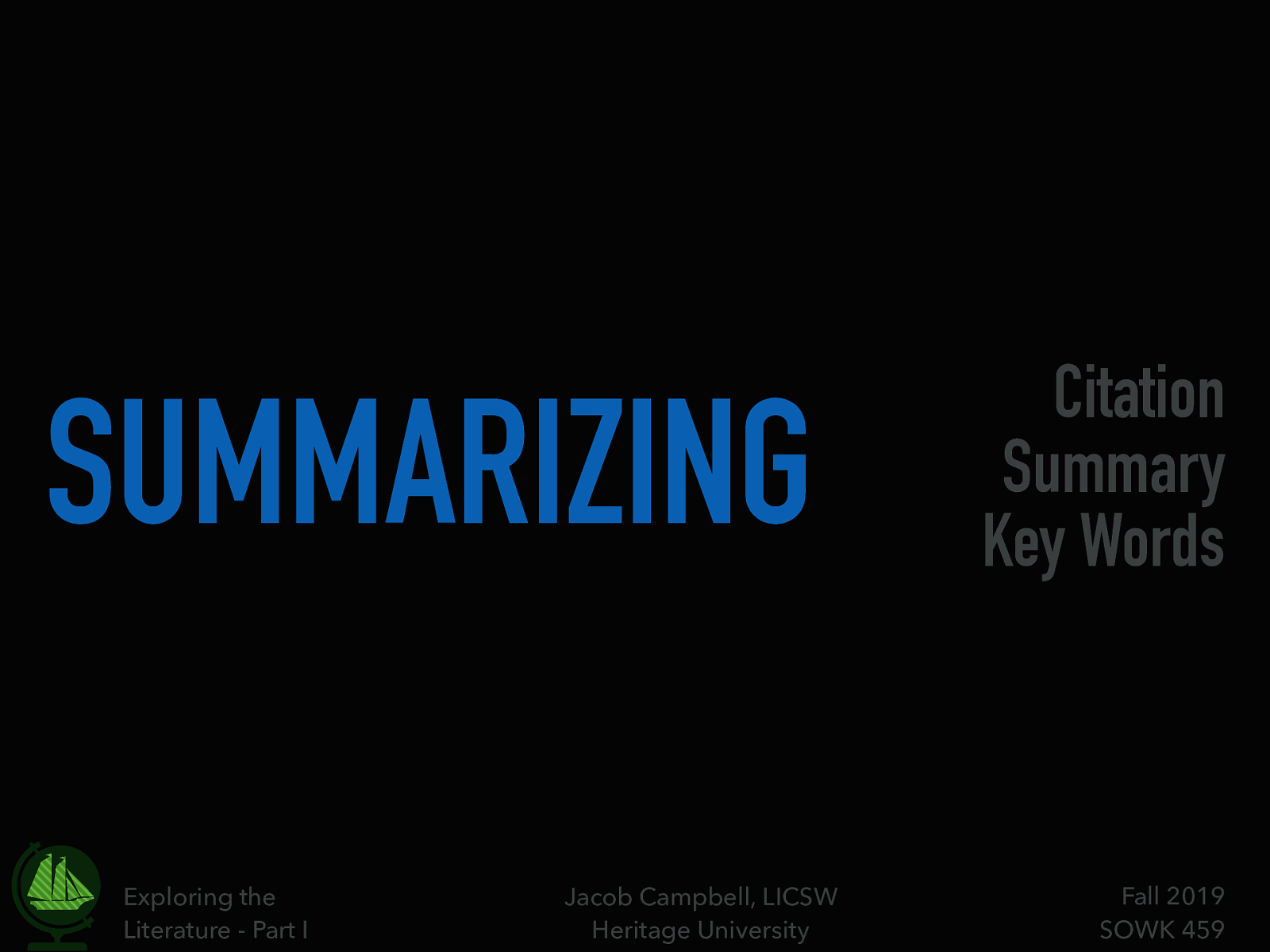
Summarizing (1 of 9)
Along with finding the important parts that Lockman describes, it is important for you to be able to summarize the articles.
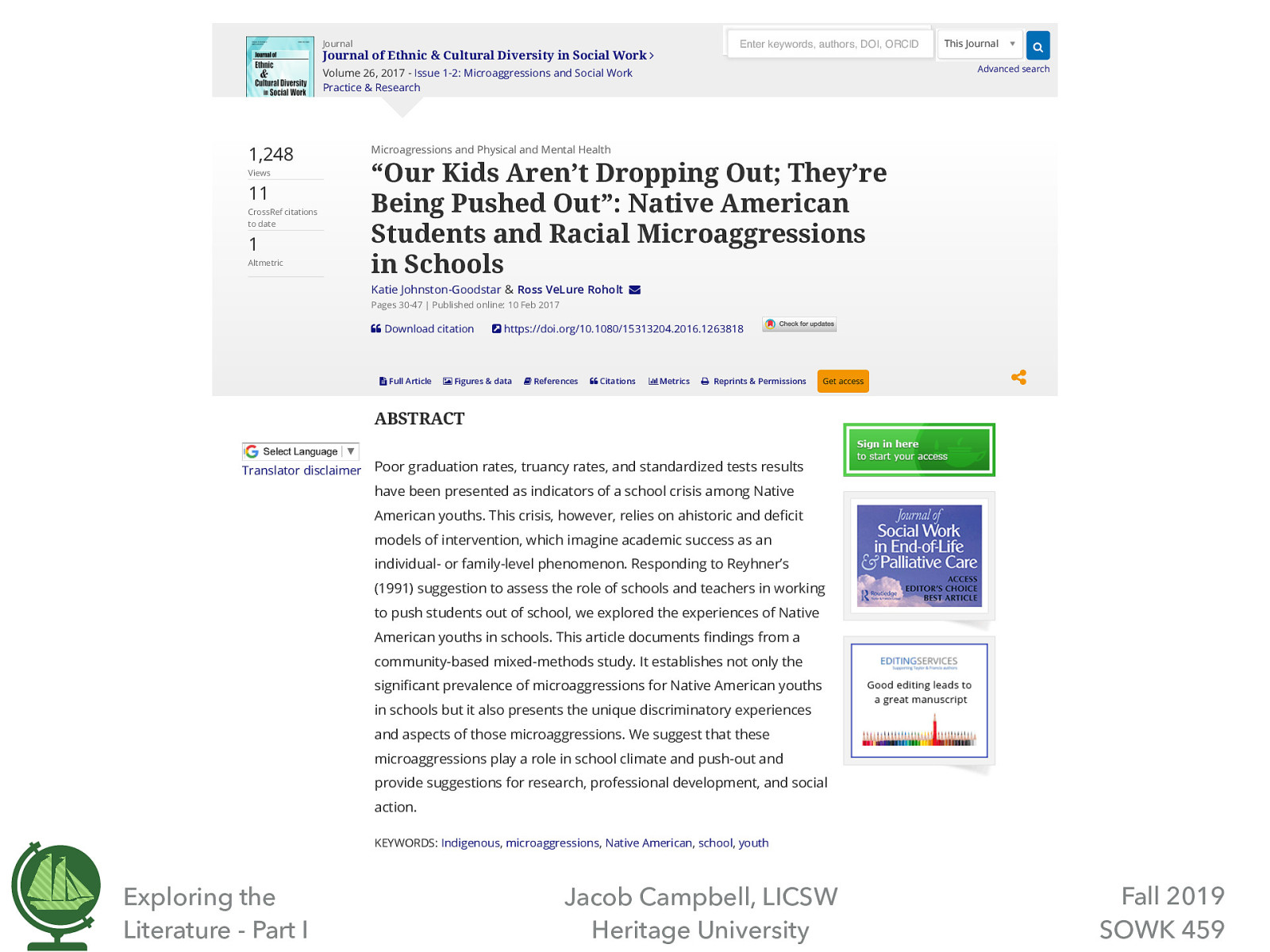
Summarizing (2 of 9) - Article Example
Lets look at this with a specific article example.
Johnston-Goodstar, K., & VeLure Roholt, R. (2017) “Our kids aren’t dropping out; they’re being pushed out” : Native American Students and racial micro aggressions in schools. Journal of Ethnic & Cultural Diversity in Social Work, 26 (1-2) 30-47, https://doi.org/10.1080/15313204.2016.1263818
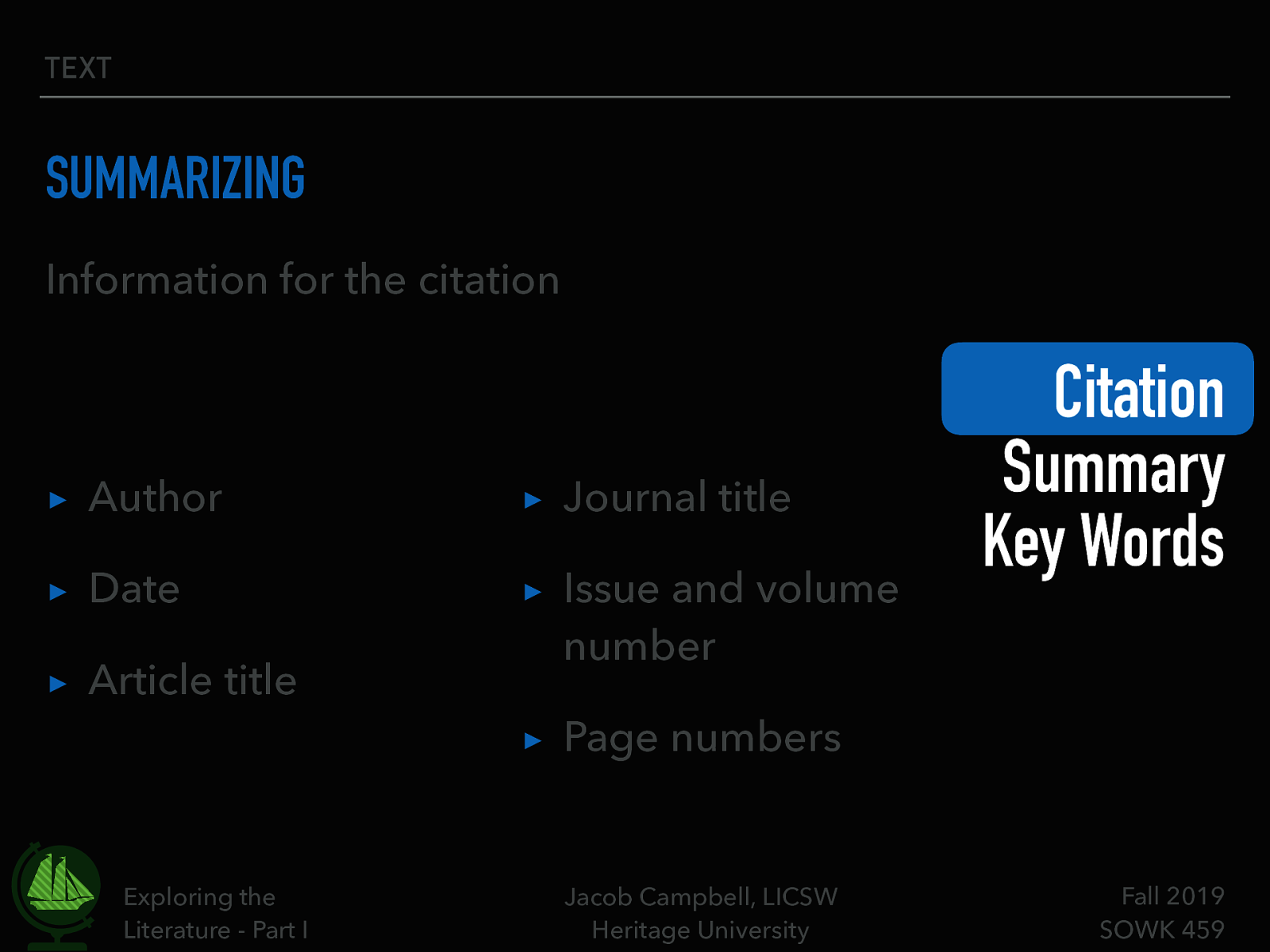
Summarizing (3 of 9) - Citation Information
When you are reading you should write down the information about the citation to keep yourself up to date or add it to citation software.
This information includes:
- Author
- Date
- Article title
- Journal title
- Issue and volume number
- Page numbers
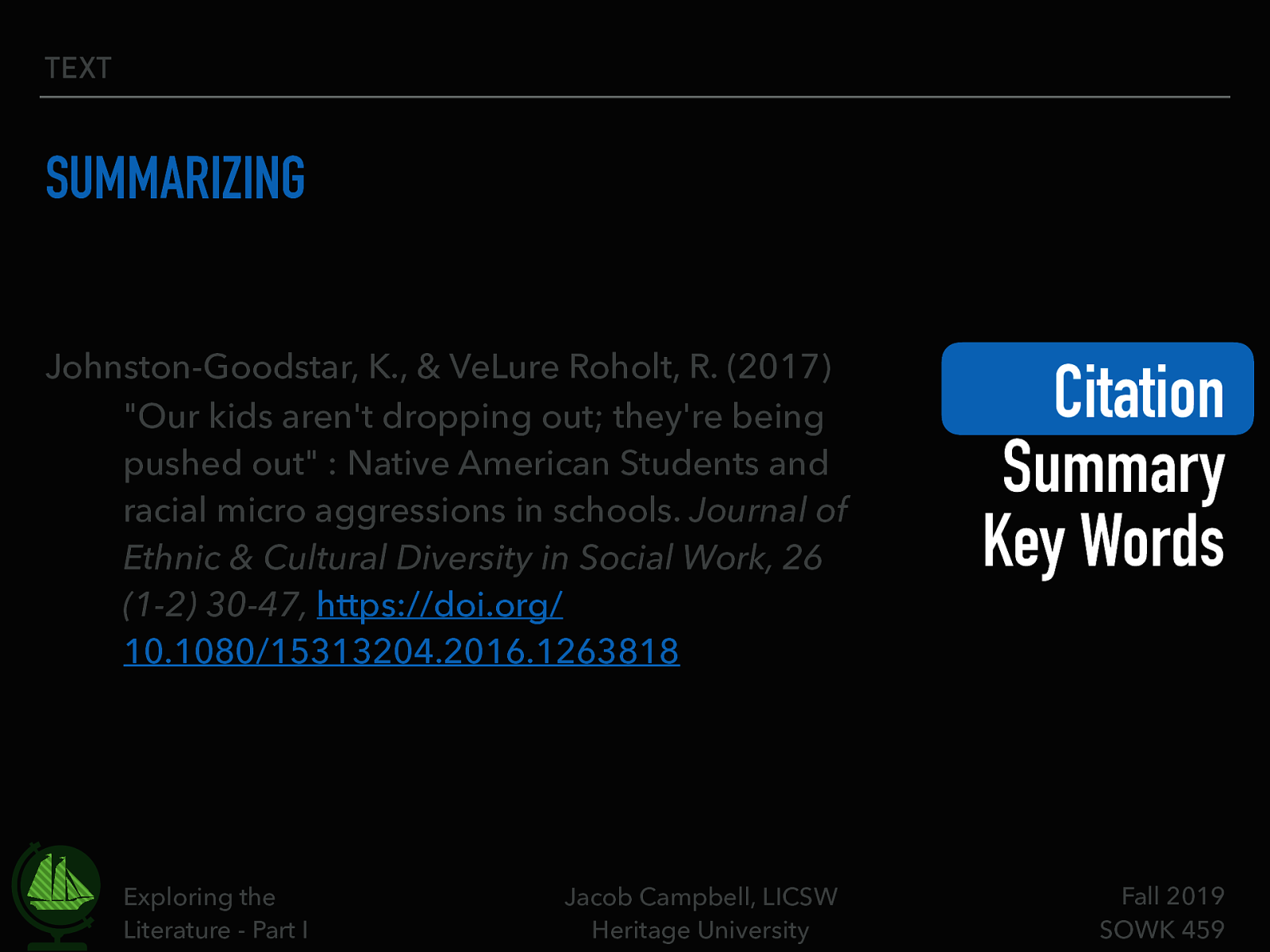
Summarizing (4 of 9) - Citation Reference List Entry
This is an example of a citation.
- Don’t just copy what the article says or the database (e.g. EscoHost)
- Look up each one until you get a better understanding
- Recognize that always have - Author (year) title. Source.
Johnston-Goodstar, K., & VeLure Roholt, R. (2017) “Our kids aren’t dropping out; they’re being pushed out” : Native American Students and racial micro aggressions in schools. Journal of Ethnic & Cultural Diversity in Social Work, 26 (1-2) 30-47, https://doi.org/10.1080/15313204.2016.1263818
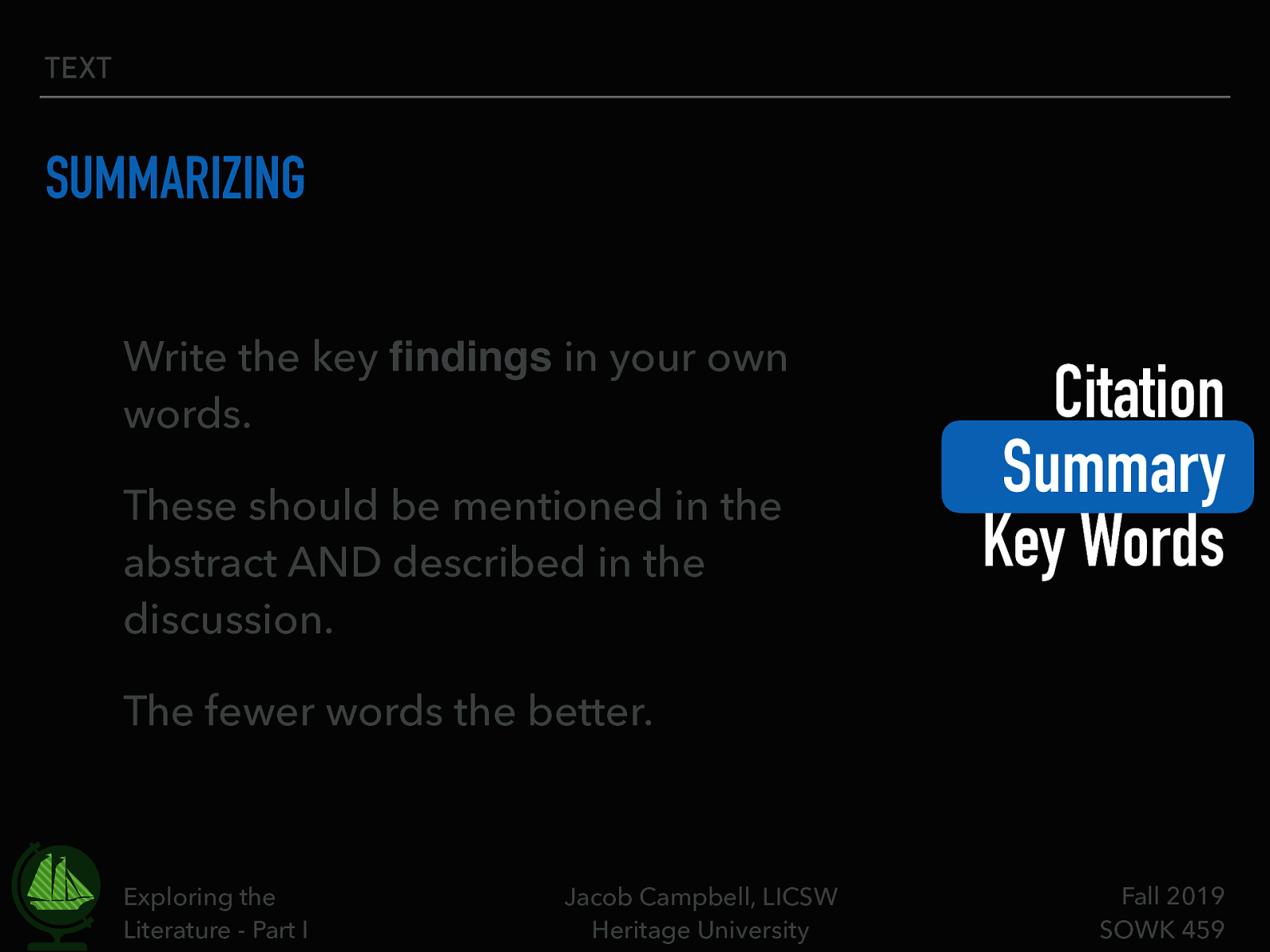
Summarizing (4 of 9) - Citation Reference List Entry
You should take notes. One useful way of doing this is to keep note cards so that you can refer back to them.
Write the key findings in your own words. These should be mentioned in the abstract AND described in the discussion. The fewer words the better.
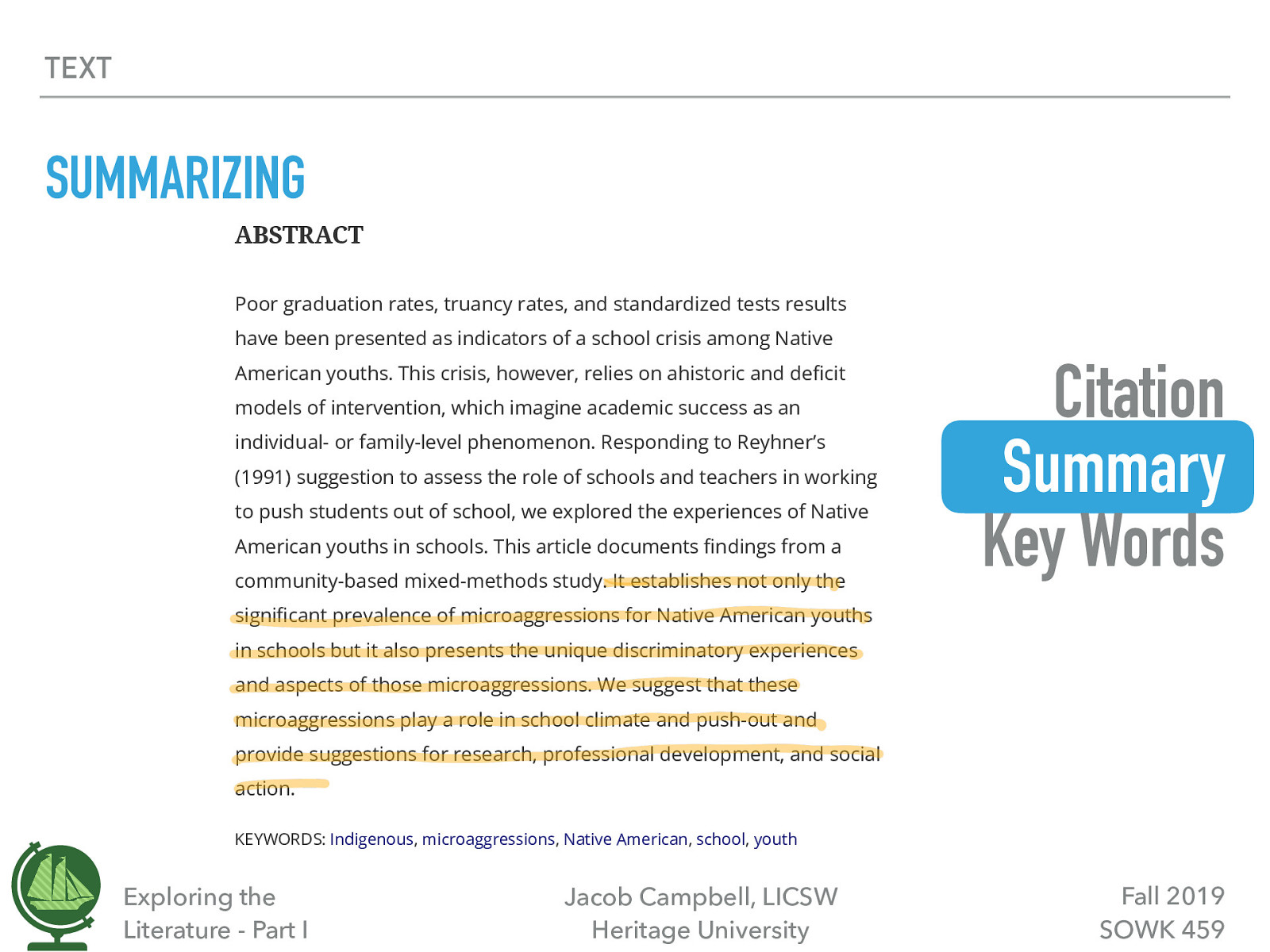
Summarizing (6 of 9) - Summary from Abstract
You can summarize from the abstract, but you won’t get as detailed of information
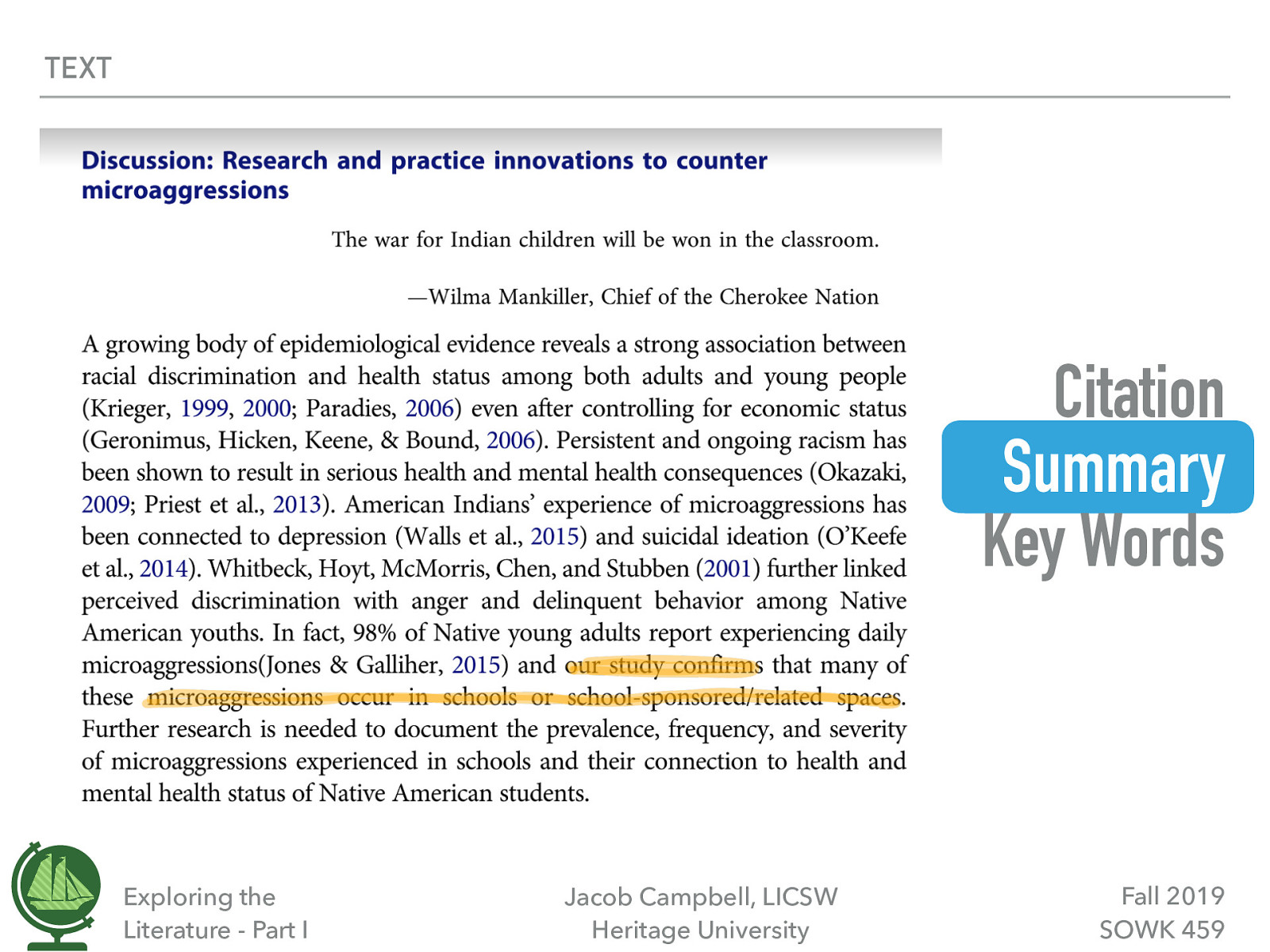
Summarizing (7 of 9) - Summary from Paper
Find those summaries in the article for better details.
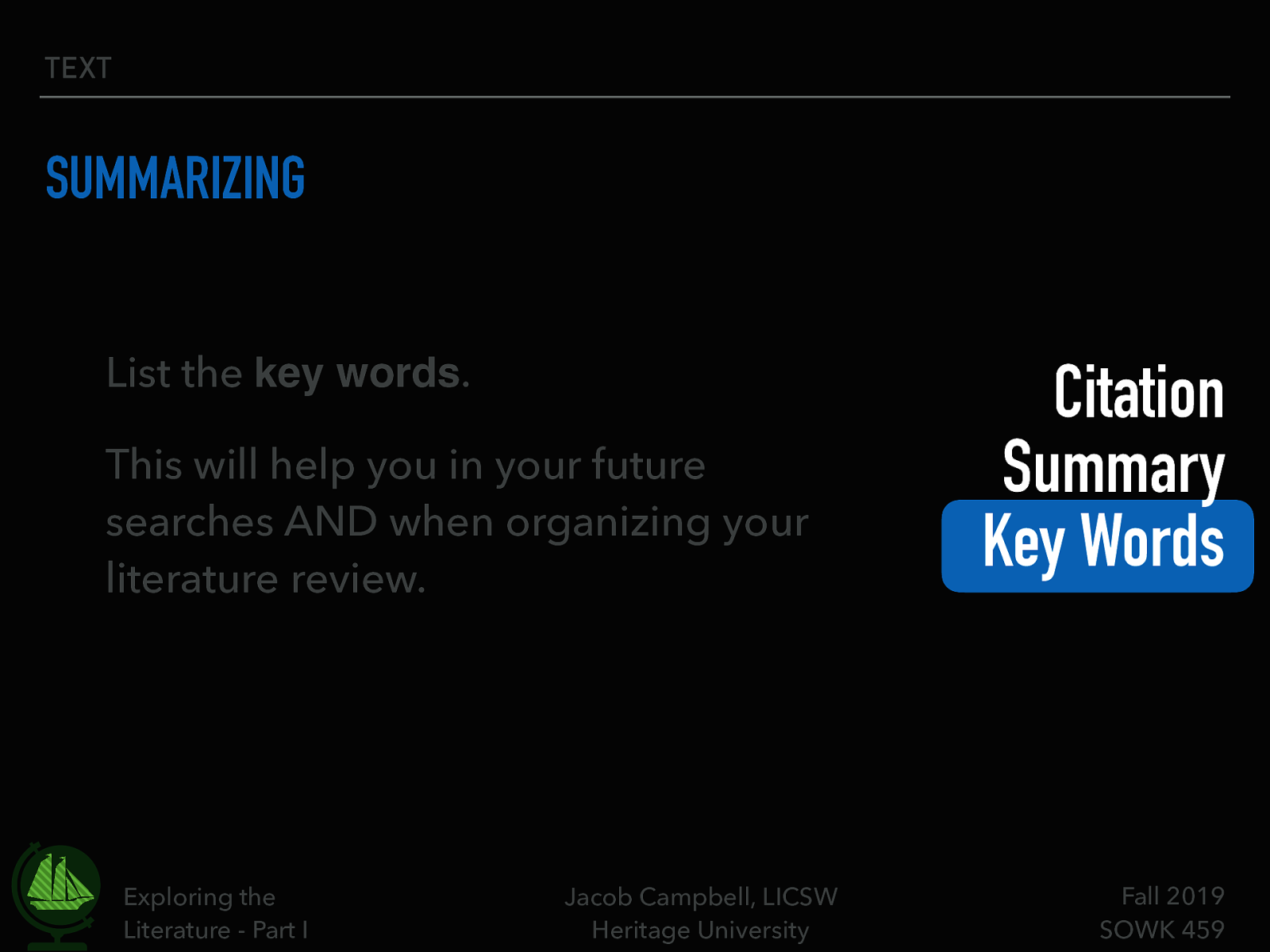
Summarizing (8 of 9) - Key Words
Helpful to review the key words provided by the author. Helps find other articles that have similar topics. Helps you to understand the taxomimy that is used for your subject. Use those words to describe things.
- List the key words.
- This will help you in your future searches AND when organizing your literature review.
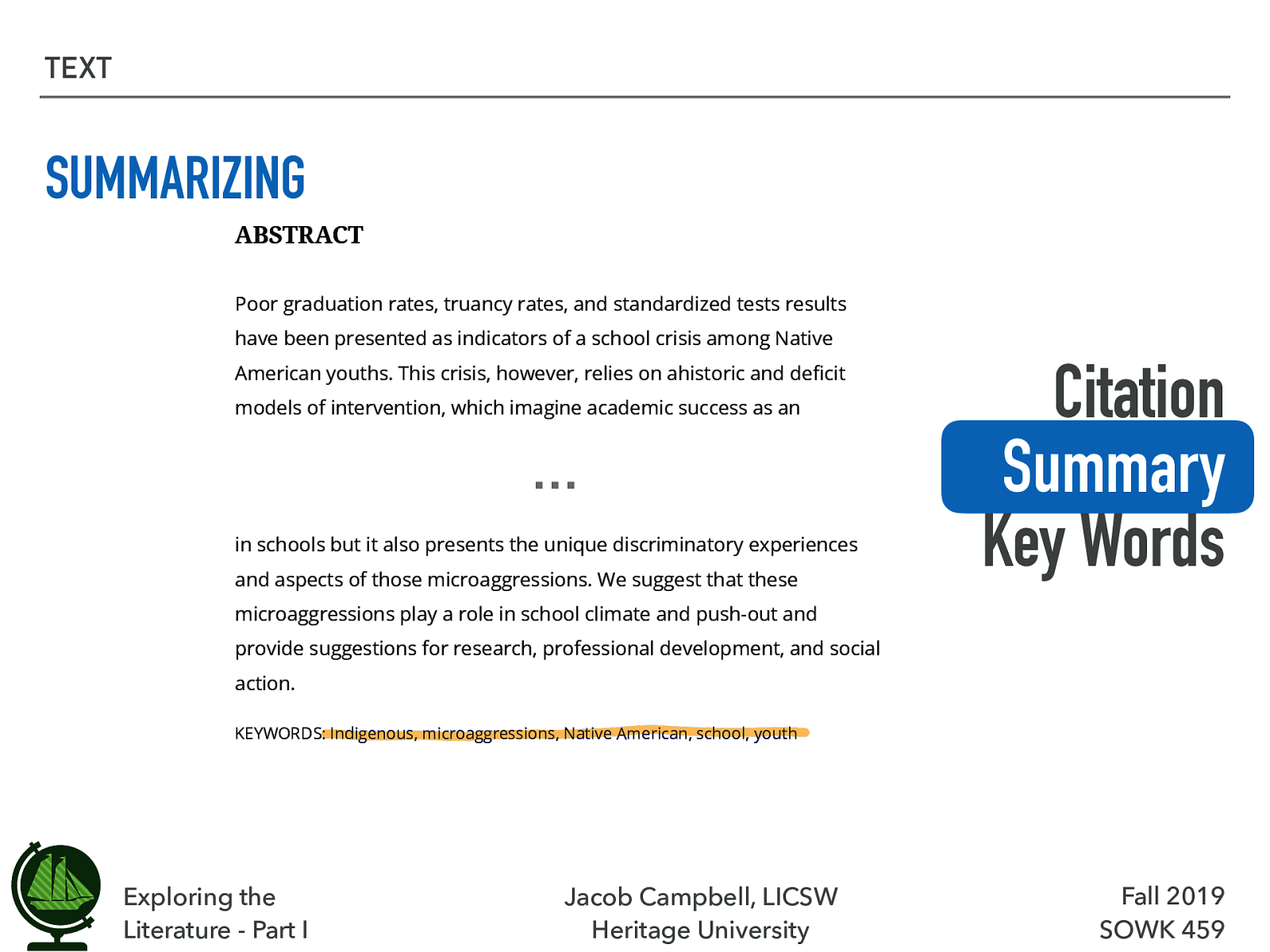
Summarizing (9 of 9) - Key Words from Abstract
They are usually with the abstract.
![[Video] Evaluating Journal Articles with the CAARP Test](https://on.notist.cloud/slides/deck3658/large-23.jpg)
[Video] Evaluating Journal Articles with the CAARP Test
[Whole Class Activity] Watch the video. Discussion about what to do to evaluate a source.
Mallon, M. (2012 August 13) Evaluating journal articles with the CAARP test. Retrieved from https://youtu.be/Q5Se7lxSANM
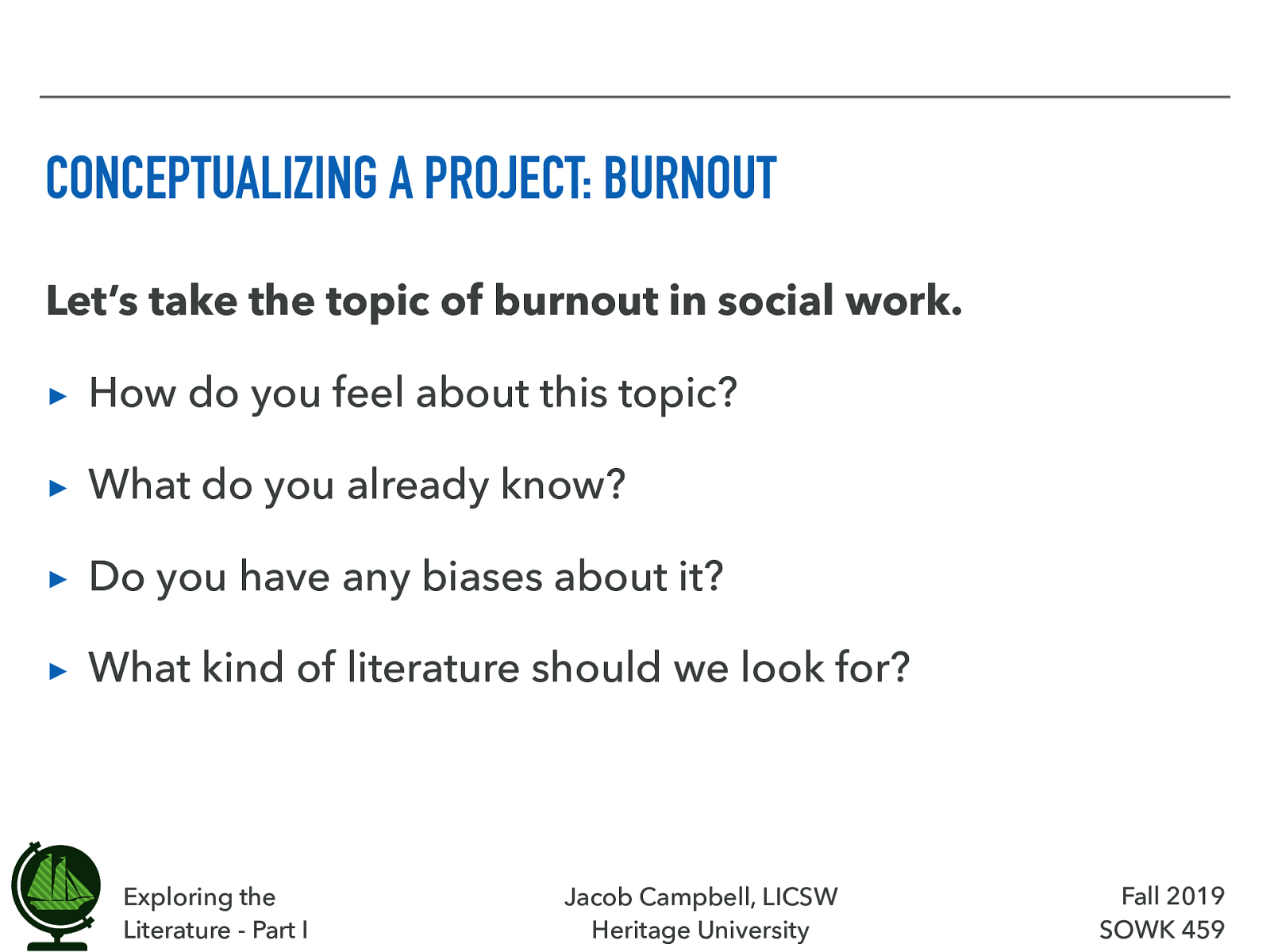
Conceptualizing a project: Burnout
To help us consider how to research a project, lets look at the topic of burnout.
Let’s take the topic of burnout in social work.
- How do you feel about this topic?
- What do you already know?
- Do you have any biases about it?
- What kind of literature should we look for?
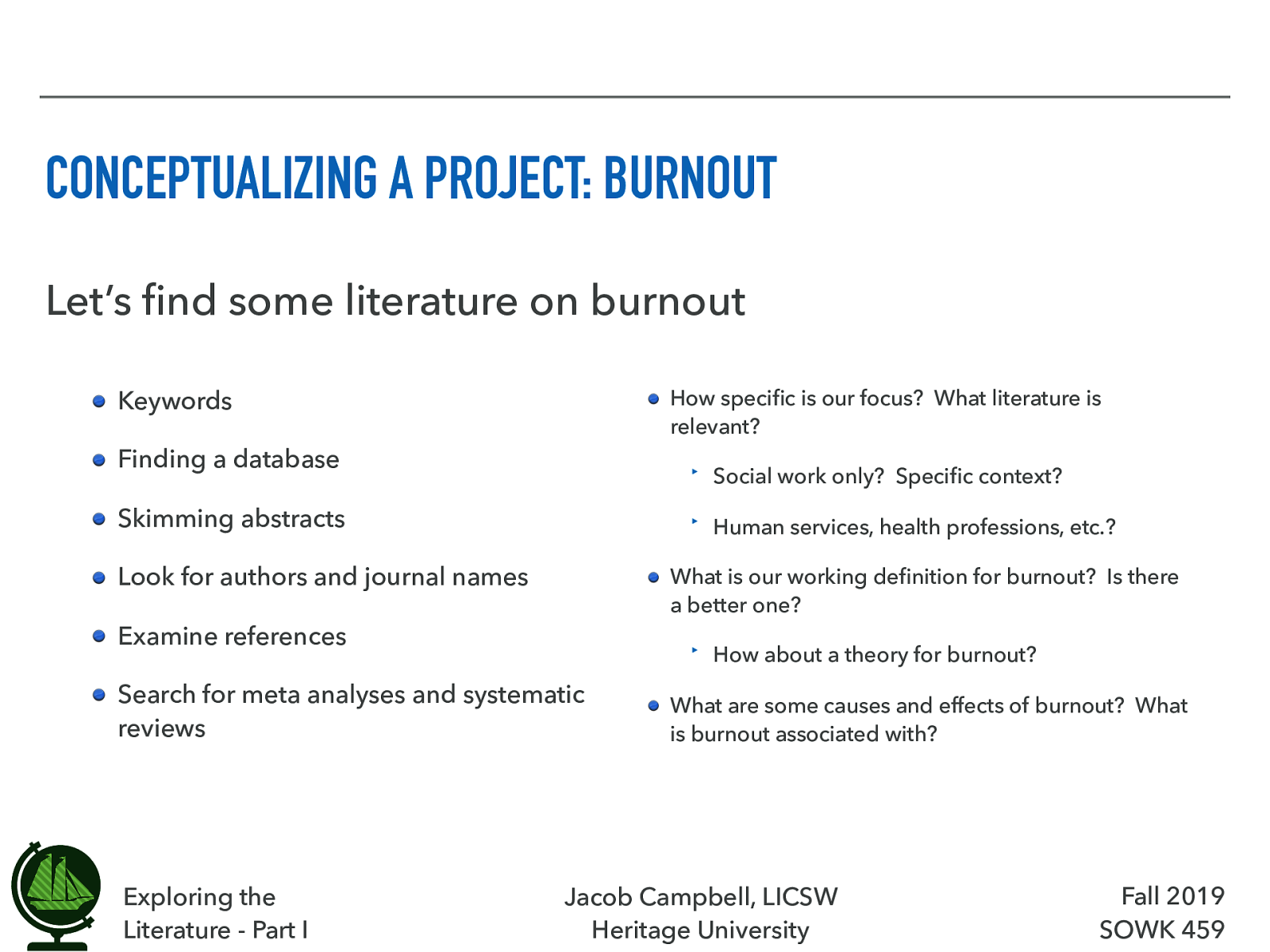
Conceptualizing a project: Burnout
Being able to look at literature, there are some things that we can do.
[Small Group Activity] In small groups with students around you, spend some time looking into burn out. Just work on getting a lay of the land.
Let’s find some literature on burnout
Keywords
Finding a database
Skimming abstracts
Look for authors and journal names
Examine references
Search for meta analyses and systematic reviews
How specific is our focus? What literature is relevant?
- Social work only? Specific context?
- Human services, health professions, etc.?
What is our working definition for burnout? Is there a better one?
- How about a theory for burnout?
What are some causes and effects of burnout? What is burnout associated with?
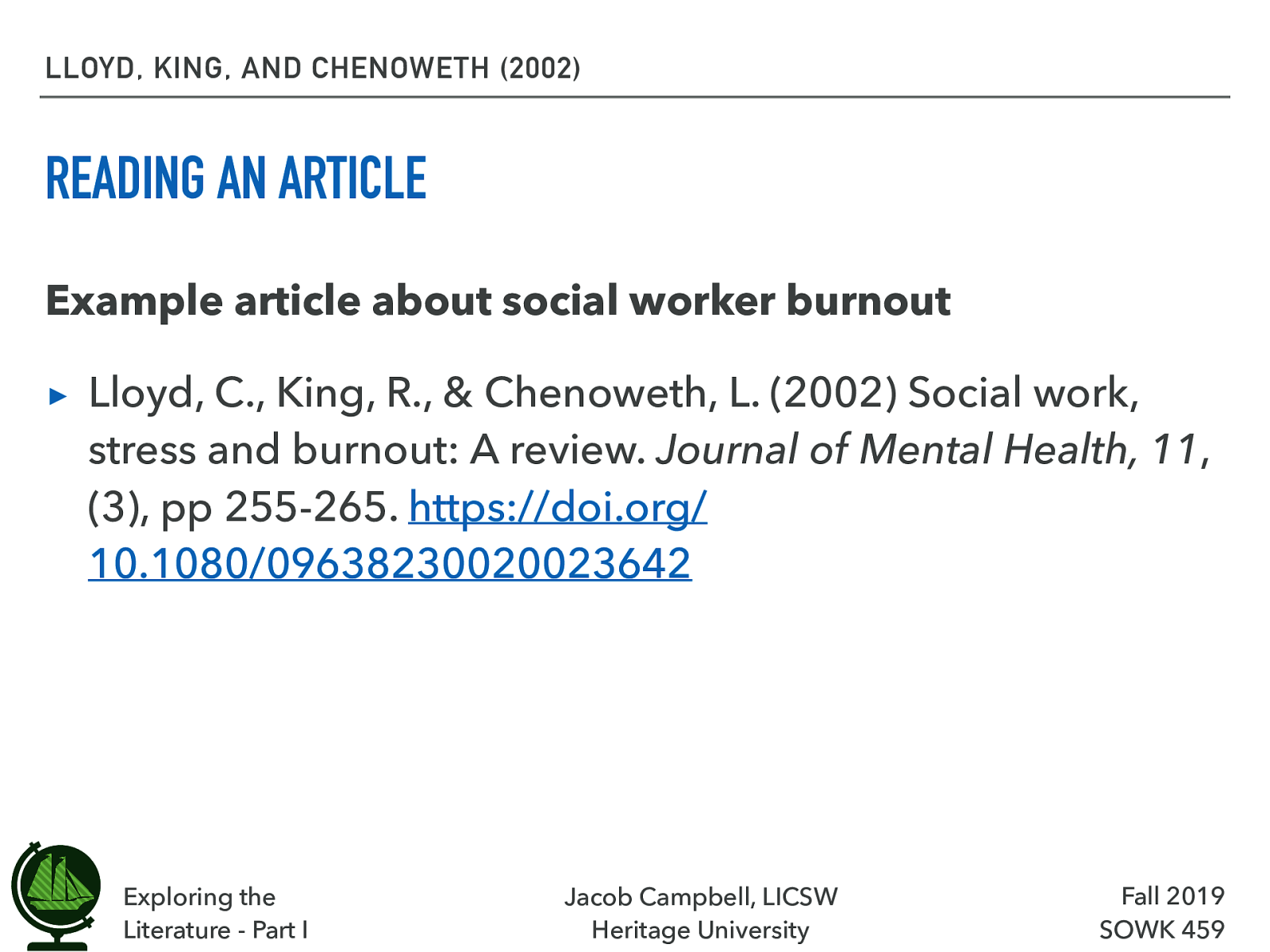
Reading an Article About Social Worker Burnout
Lets put these thoughts to use.
Example article about social worker burnout
Lloyd, C., King, R., & Chenoweth, L. (2002) Social work, stress and burnout: A review. Journal of Mental Health, 11,(3), pp 255-265. https://doi.org/10.1080/09638230020023642
Available at https://espace.library.uq.edu.au/data/UQ_62252/SocialWorkStressBurnout.pdf
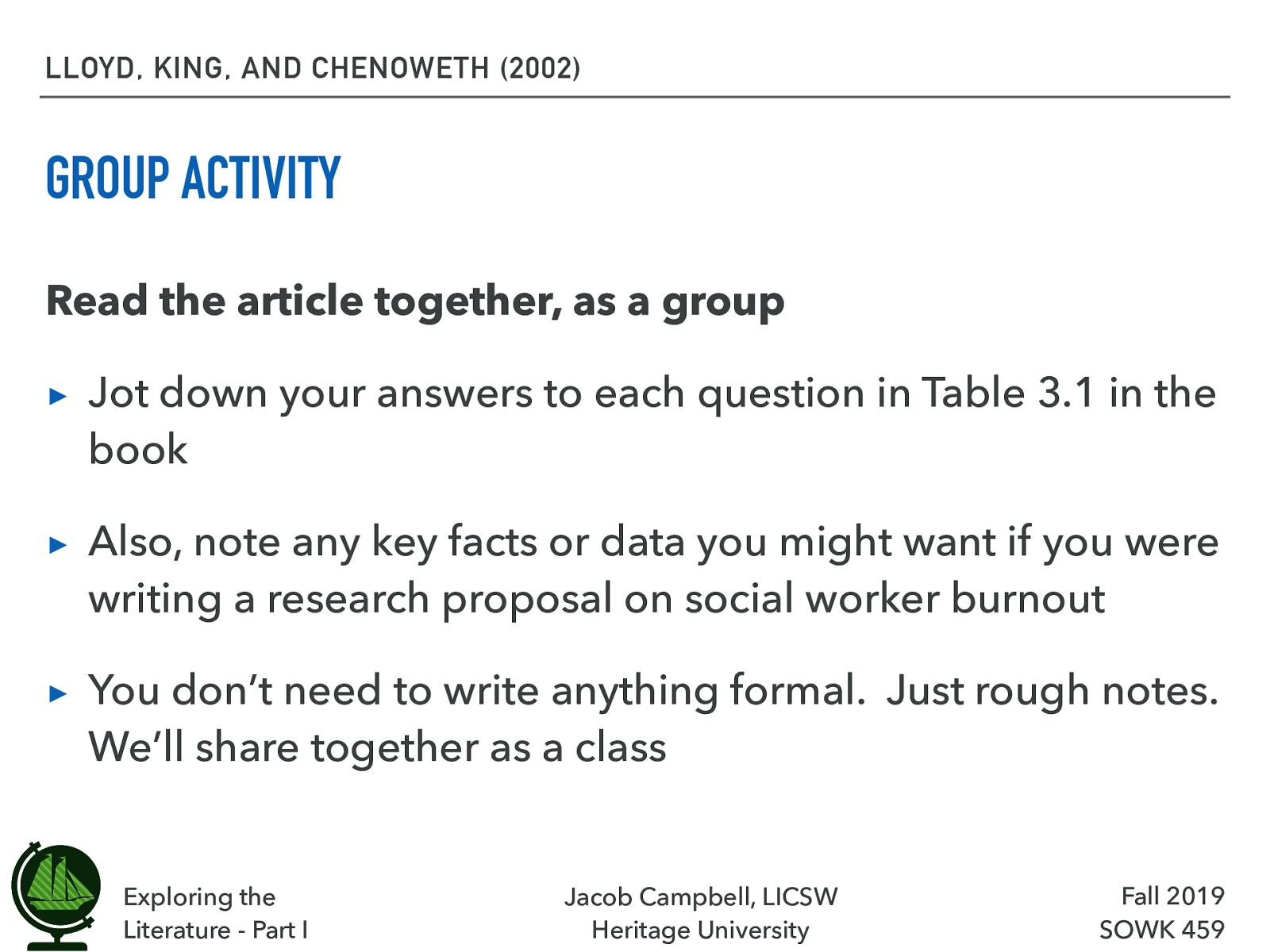
Reading an Article: Activity
You will be working in your same small groups.
Read the article together, as a group
- Jot down your answers to each question in Table 3.1 in the book
- Also, note any key facts or data you might want if you were writing a research proposal on social worker burnout
- You don’t need to write anything formal. Just rough notes. We’ll share together as a class
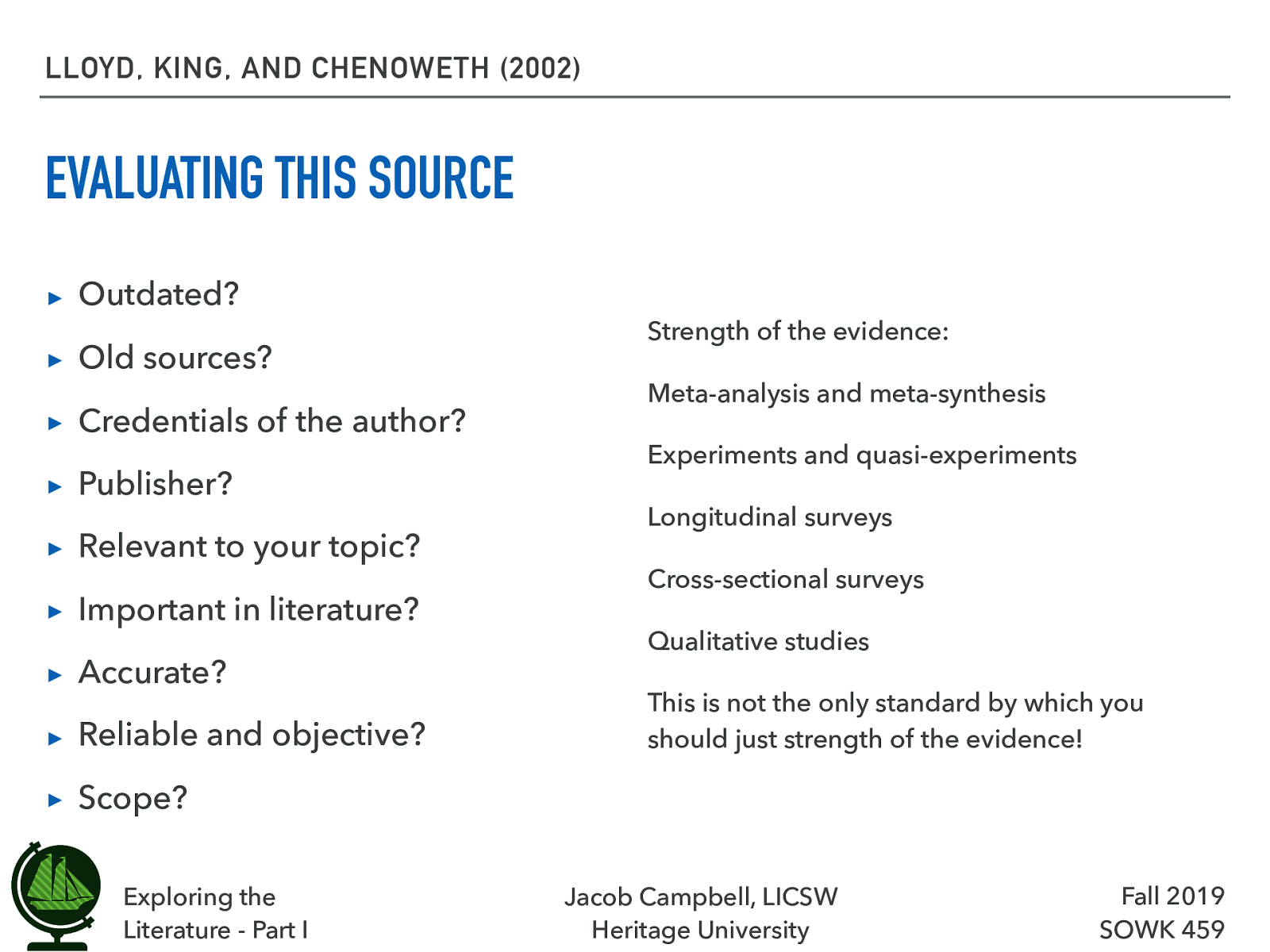
Evaluating this Source: Discussion
Evaluating this source
- Outdated?
- Old sources?
- Credentials of the author?
- Publisher?
- Relevant to your topic?
- Important in literature?
- Accurate?
- Reliable and objective?
- Scope?
Strength of the evidence:
- Meta-analysis and meta-synthesis
- Experiments and quasi-experiments
- Longitudinal surveys
- Cross-sectional surveys
- Qualitative studies
- This is not the only standard by which you should just strength of the evidence!
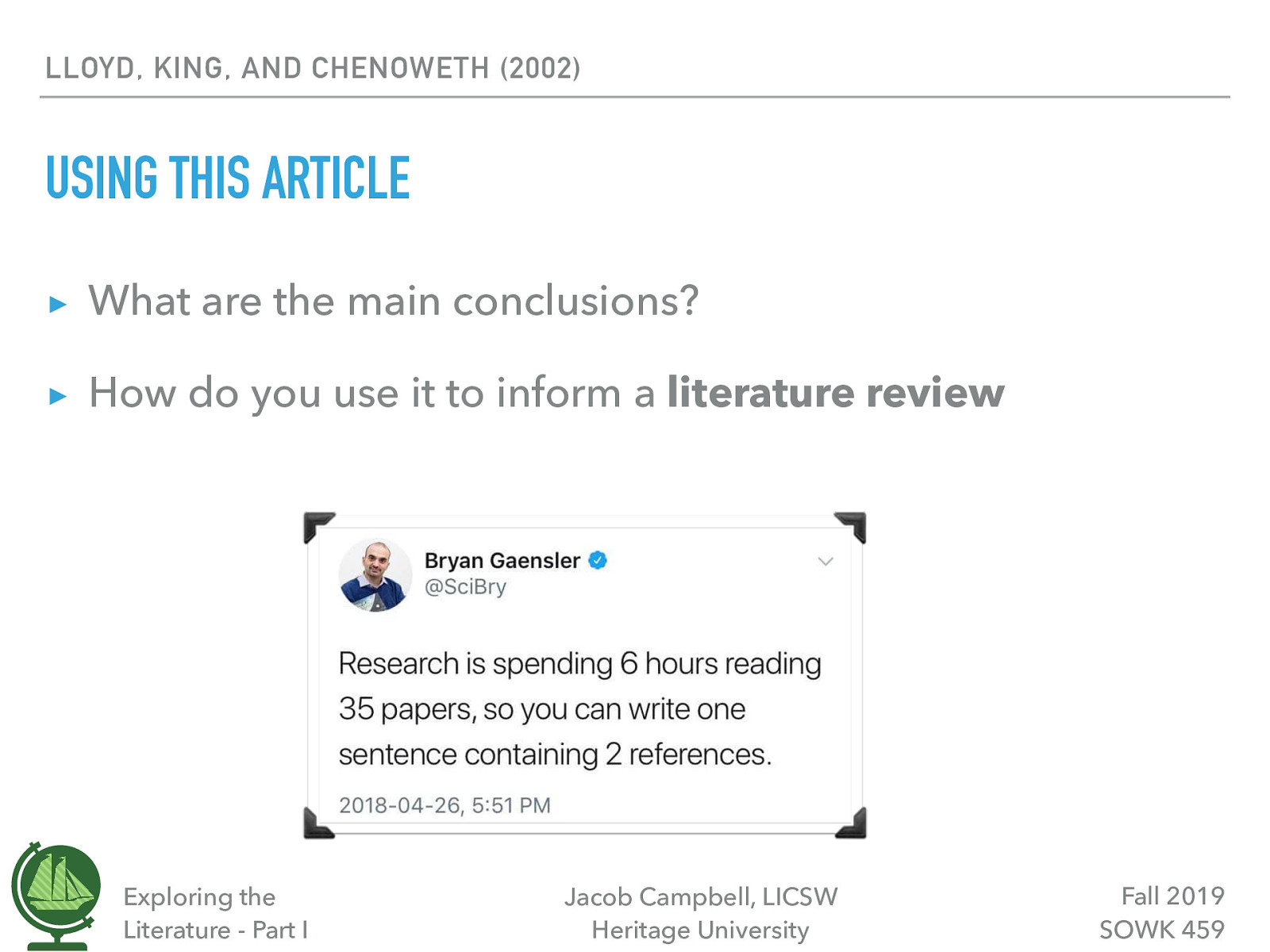
Using this article
- What are the main conclusions?
- How do you use it to inform a literature review
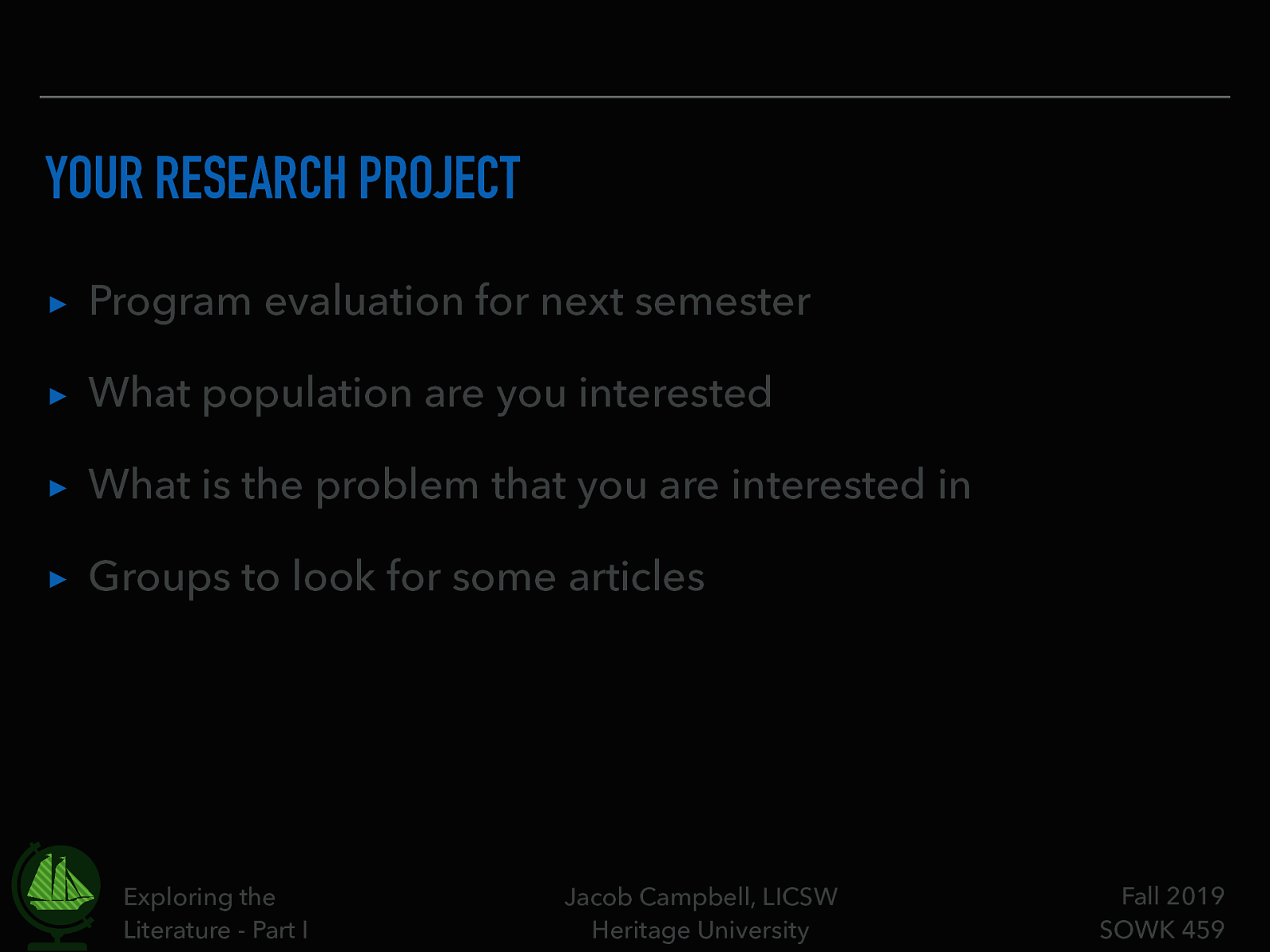
Your Research Project
- Program evaluation for next semester
- What population are you interested
- What is the problem that you are interested in
- Groups to look for some articles
This week is a dive into understanding research. The agenda is
- Reading and understanding scholarly journal articles
- Distinguish between high-quality and low-quality journal articles
- Summarize a journal article
Buzz and feedback
Here’s what was said about this presentation on social media.
-
I probably spend too much time making a pretty presentation... when I make something like this it really brings me joy and I think it's useful. Video is a screen recording of the anatomy of a scientific paper. Created in #Apple #Keynote Inspiration(https://t.co/uX431ITCp5) pic.twitter.com/nMWJZuH3Ti
— Jacob Campbell (@campjacob) September 24, 2019
